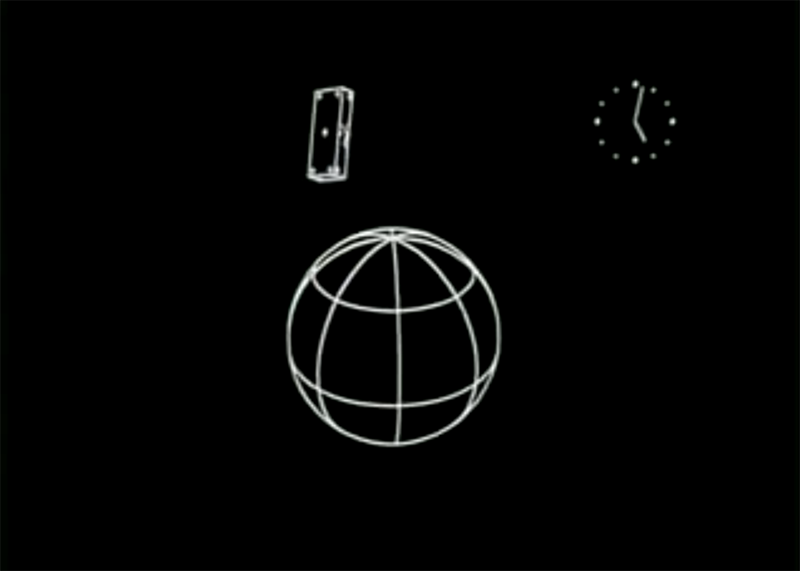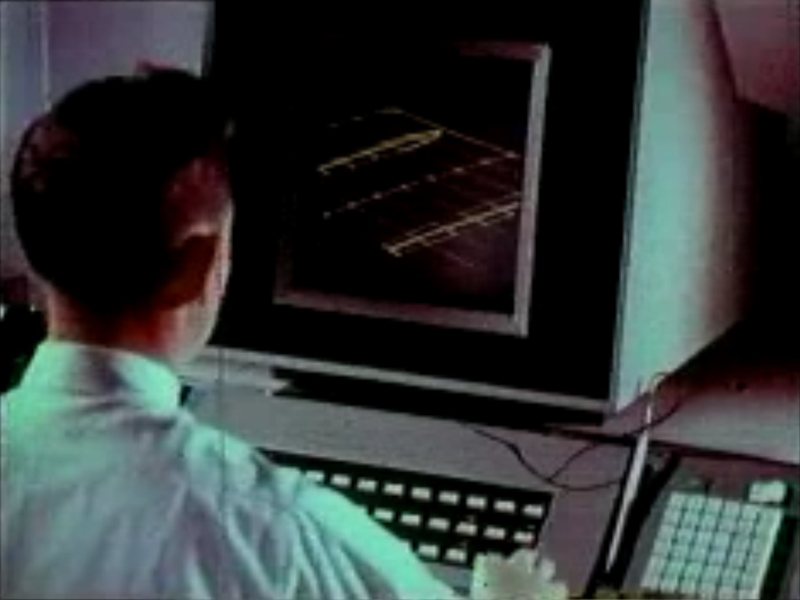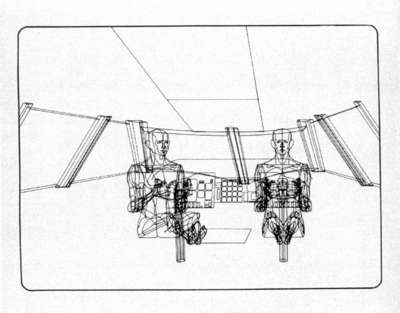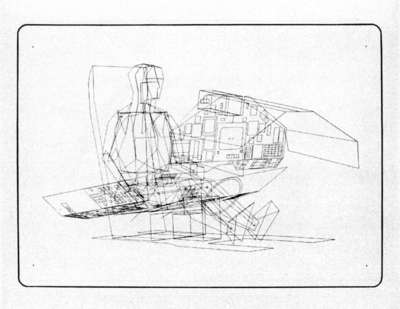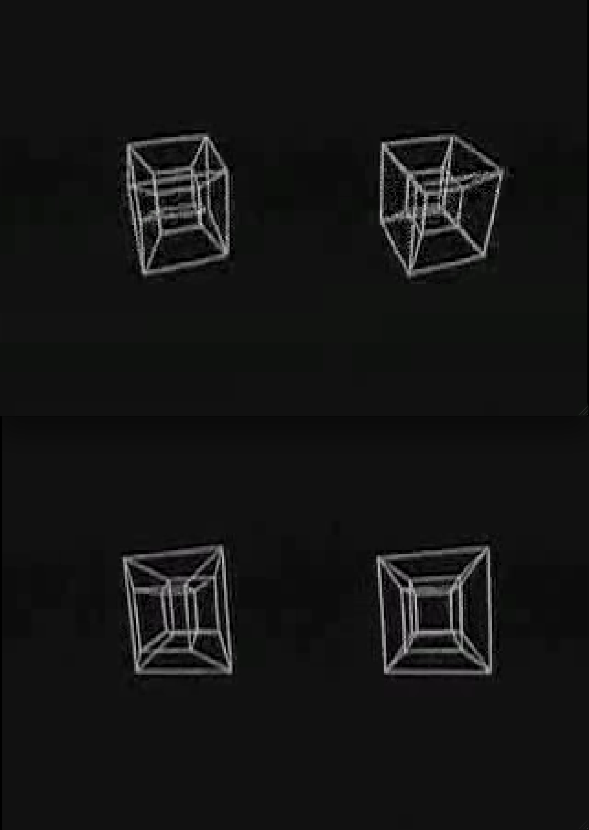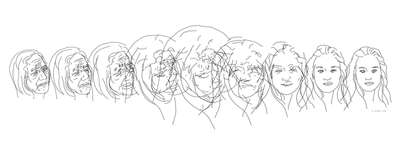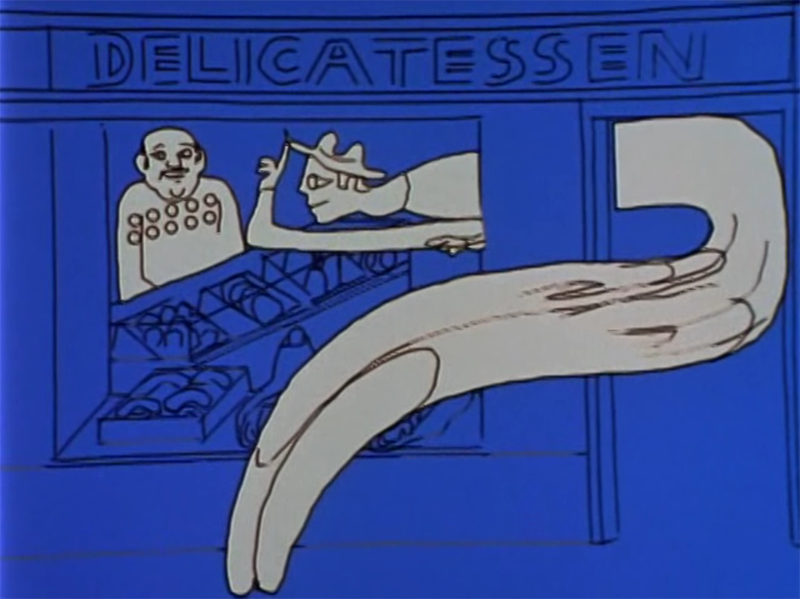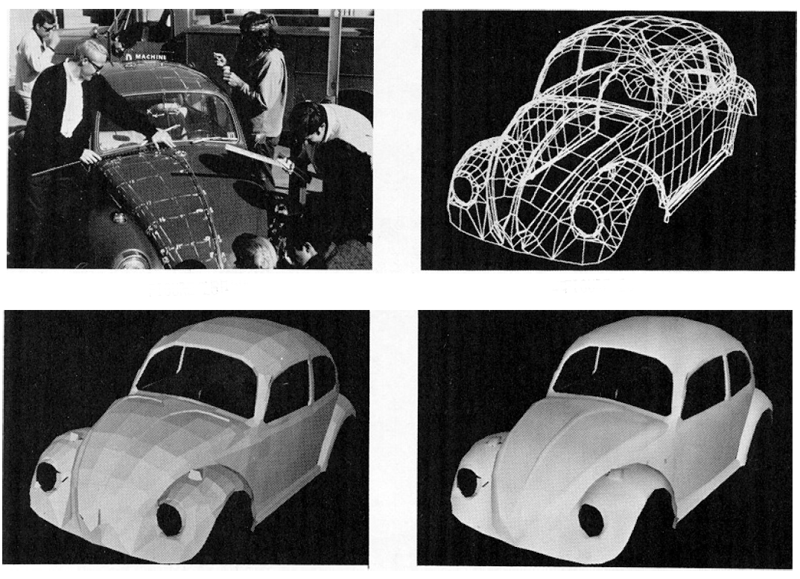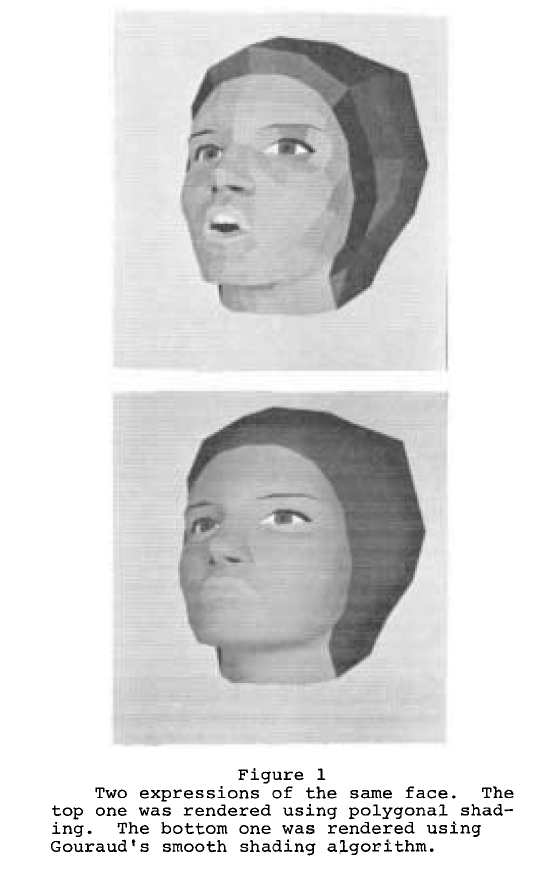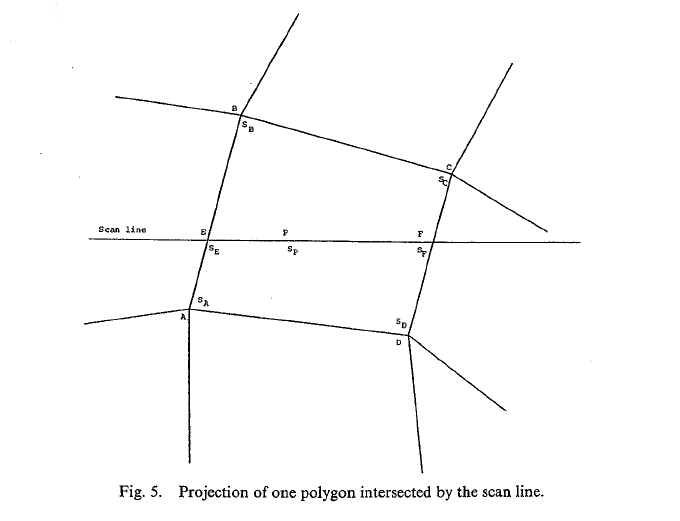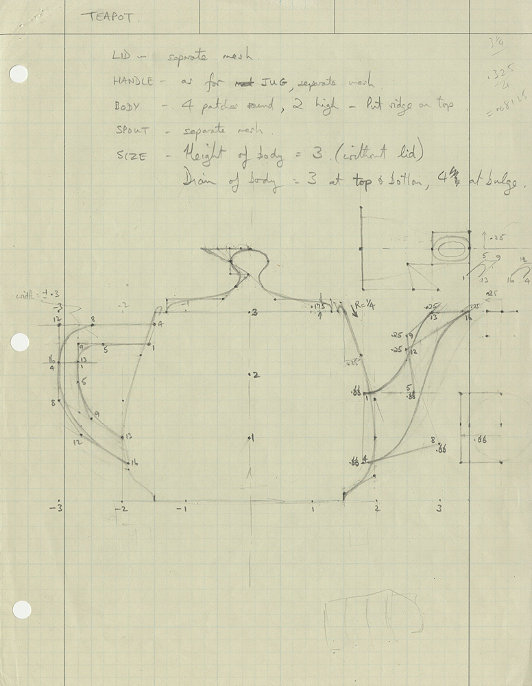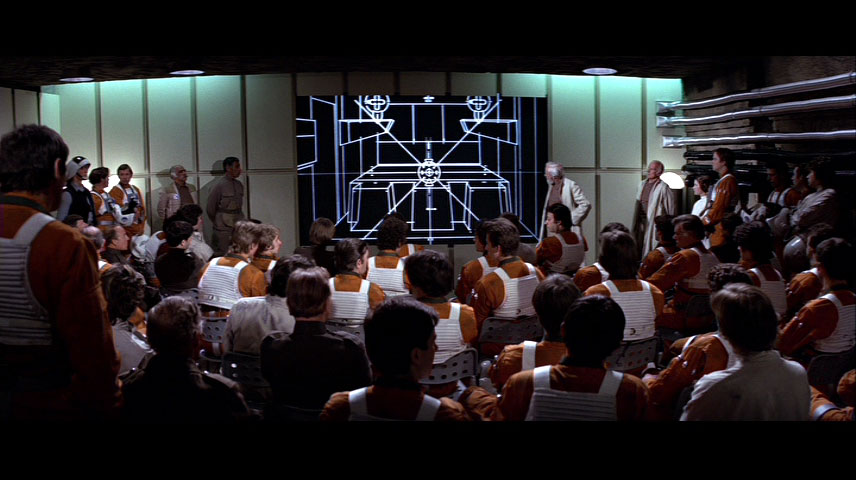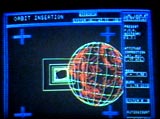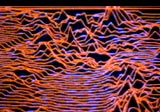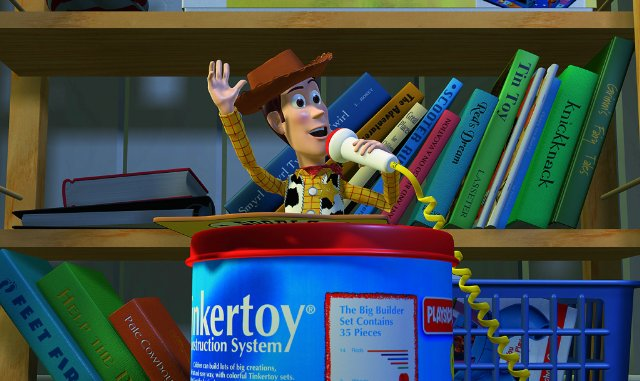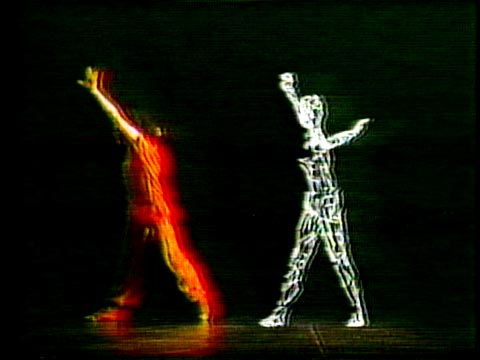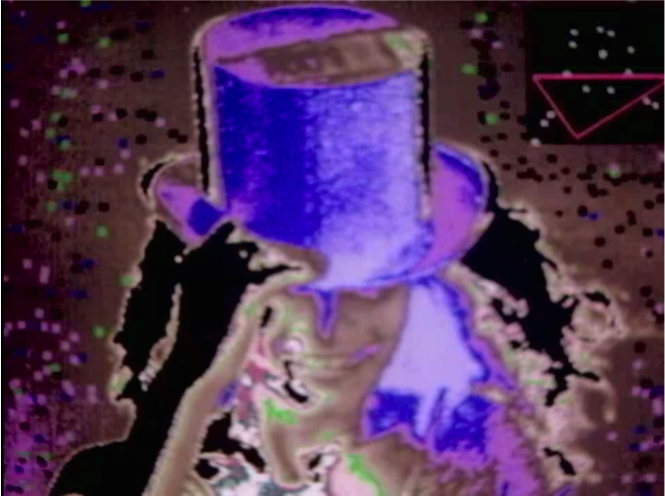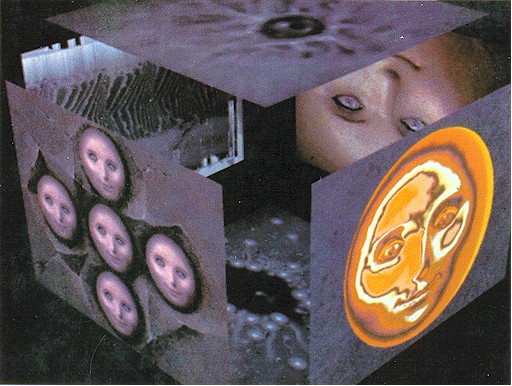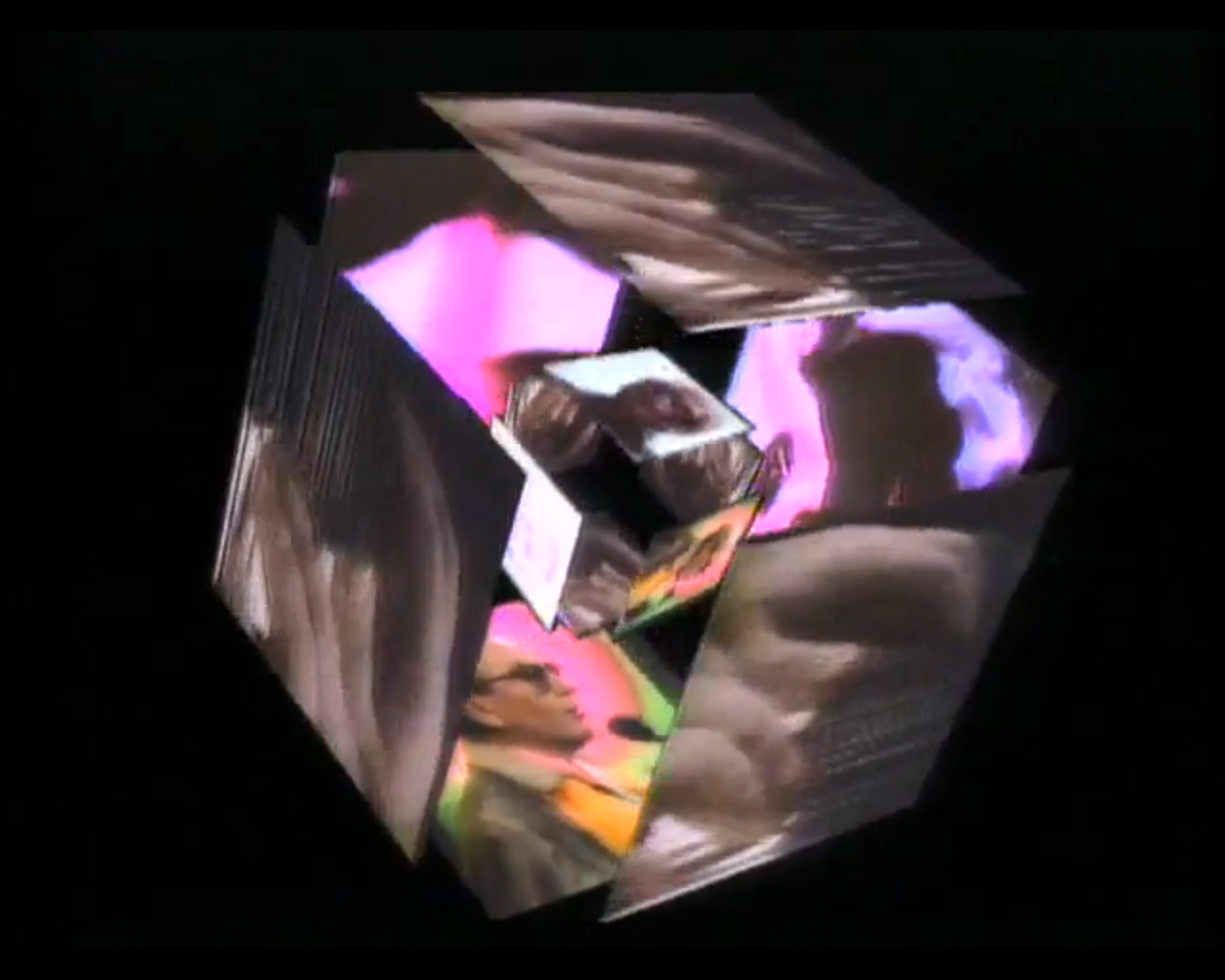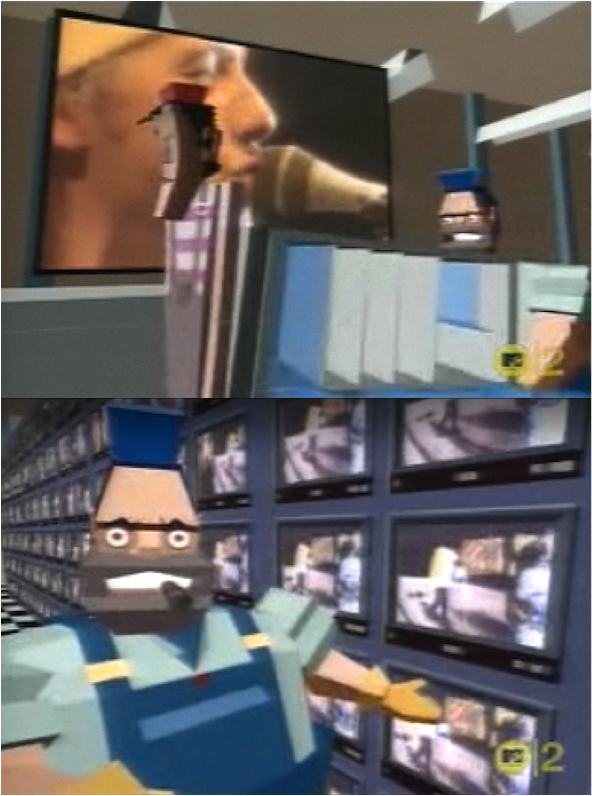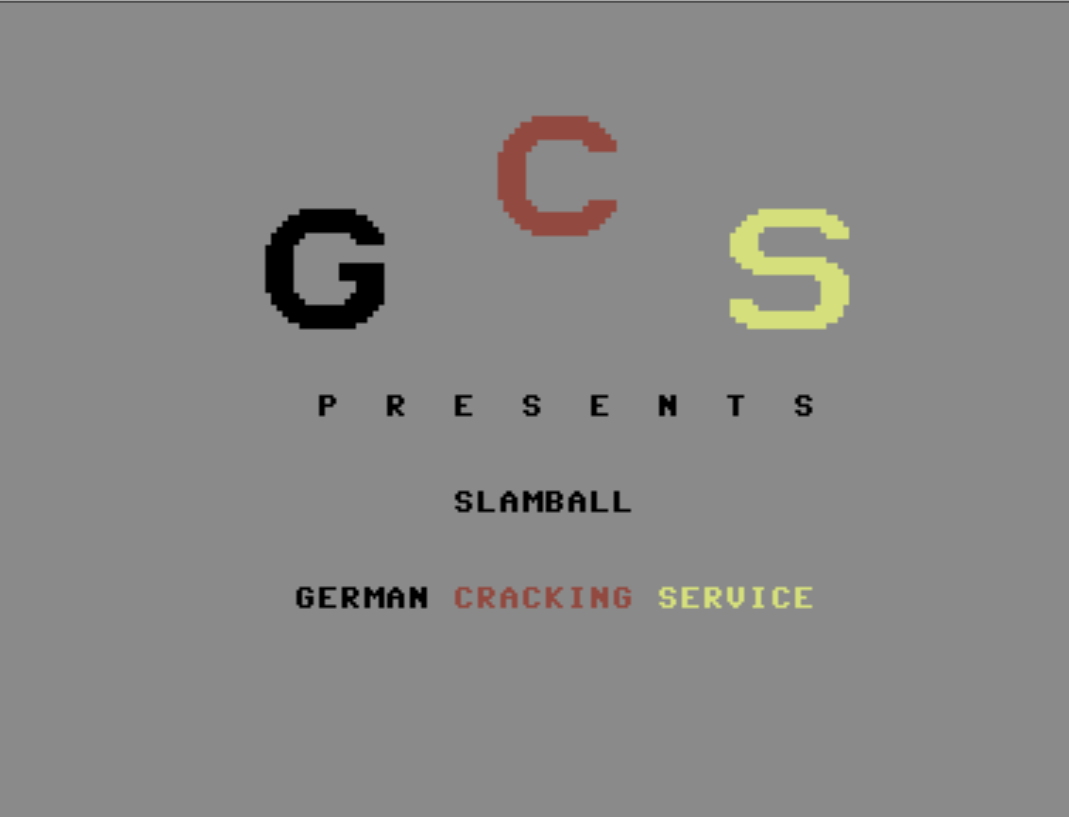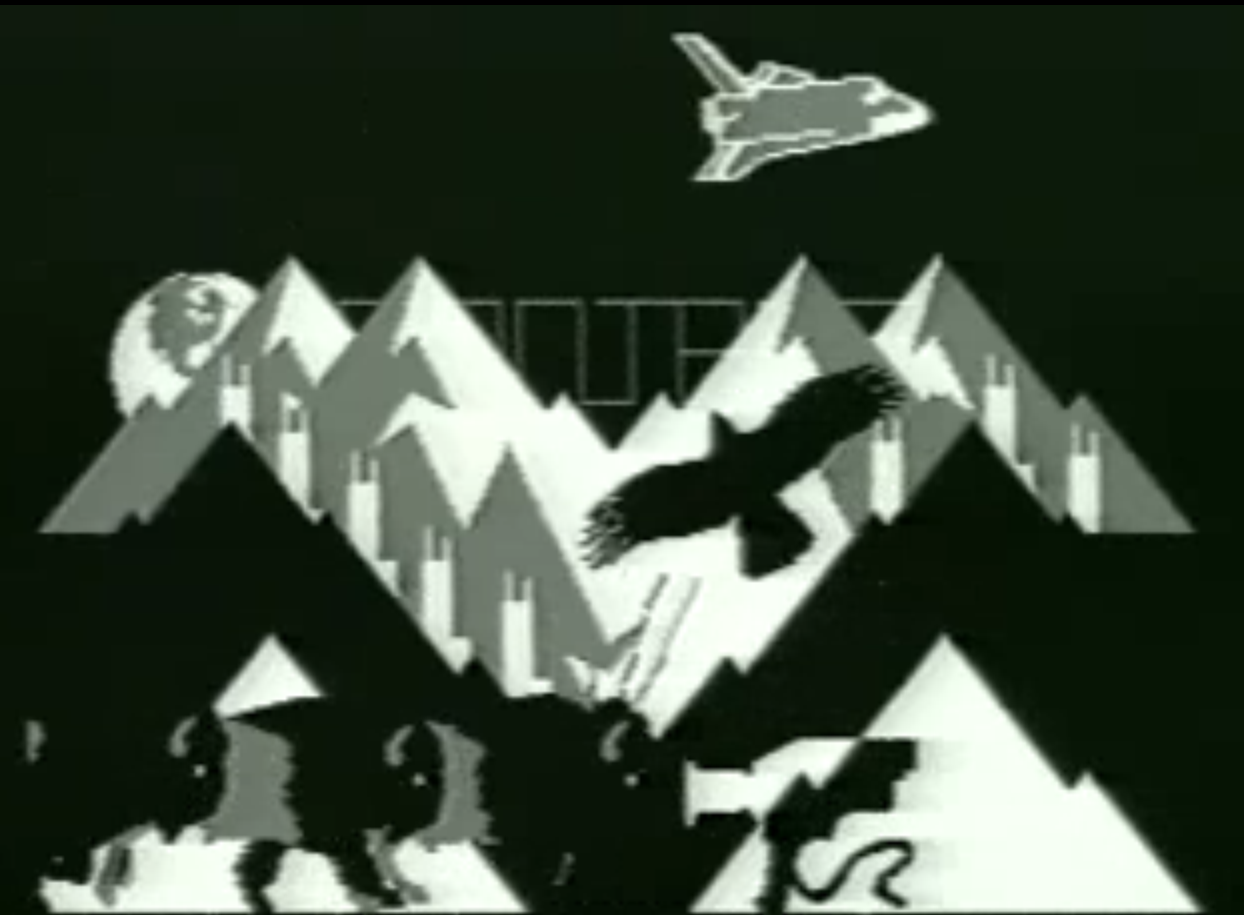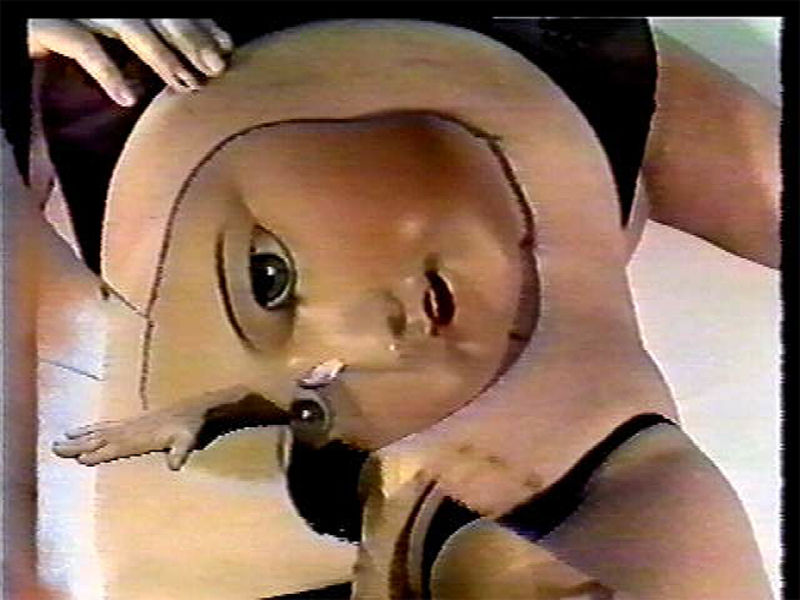IASLonline NetArt: Theory
Thomas Dreher
History of Computer Art
IV. Images in Motion
IV.2 Computer Animation
- IV.2.1 The Development from the Sixties to the Eighties
- IV.2.1.1 An Outline
- IV.2.1.2 The Sixties
- IV.2.1.3 The Seventies
- IV.2.1.4 The Eighties
- IV.2.1.4.1 Film Sequences
- IV.2.1.4.2 Music Videos
- IV.2.1.4.3 Demoscene
- IV.2.1.4.4 The Techno-Imaginary
- Illustrations Part V: Computer Animation: PPT / PDF
- Illustrations Part VI: Music Video and Demoscene: PPT / PDF
- Table of Contents
- Bibliography
- Previous Chapter
- Next Chapter
The history of the digital computer animation starts in the sixties. The early computer graphics with configurations of lines representing three-dimensional bodies were mounted to construct film sequences "frame-by-frame". 1 The sixties and seventies were the pioneering years in the development of animation software for the programming of moving objects. This software was developed at universities in the U.S.A., for example at the Ohio State University and at the University of Utah. 2 In the eighties proprietary animation software was developed by and for commercial firms using it for 3D animations in sequences for movies and commercials as well as for TV spots and music videos.
Since the early days of the demoscene in the eighties the creators present their animations on public demo-parties. In the demoscene the storing of images in a "frame-by-frame" procedure on carriers has been, was and is obsolete: Authors of demos generate moving combinations of texts and images by codes controlling the graphics cards of personal computers. The members of the demoscene communicated with each other about the programming. 3 Demo-codes were offered on bulletin board systems (see chap. VI.1.2) for download.
In the eighties mainframe computers were utilised to produce animations for film sequences according to the tasks presented by the storyboards for movies. Meanwhile the sequences for movies were realised by following the requirements of the plots, the creators of music videos combined techniques of computer animations with procedures used in experimental films and videos. Further alternatives to movies offered films by artists who partially took up some elements of the animation software developed in the seventies for mini- and microcomputers 4, and the demoscene. Its members competed with each other in demonstrations of their capabilities to develop real time animations for the limited technical possibilities of personal computers (A summary of the eighties´ developments offer the last three sections of chap. IV.2.1.4.3).
In 1963 Edward E. Zajac constructed the first computer animation at the Bell Laboratories (Murray Hill/New Jersey). A box with edge lines gyrated round a sphere. The sphere should outline the earth and the box should represent a satellite gyrating round the earth. The satellite always turned only one of its sides to the earth: "Gyro gravity gradient attitude control system" was the film´s title and its content. The frames were programmed in FORTRAN and generated by a mainframe computer IBM 7090 (since 1959). A Stromberg-Carlson 4020 Microfilm Recorder (made by General Dynamics/Electrics, San Diego/California, since 1959) presented and stored results. 5
Zajac, Edward E.: Gyro gravity gradient attitude control system, film, 1963. Bell Laboratories, Murray Hill/New Jersey.
In the following the development of two and three dimensional computer graphics are presented because they provided the preconditions for the developments of computer animation.
In 1963 Ivan Edward Sutherland presented "Sketchpad" in his dissertation: Points could be marked on a monitor. Then an analogue computer (Lincoln TX-2, since 1957) followed instructions to build either lines or circles between the points. For the choice of instructions a little box with knobs stood beside the computer´s manual. With "Sketchpad" it became easier to accomplish two-dimensional drawings or plans with many repeated or varied elements. Sutherland´s interface was planned to allow an easy application. 6 Beside Douglas Carl Engelbart´s research developments at the Stanford Research Institute "Sketchpad" was one of the early user-friendly human-computer interfaces (HCI, see chap. VIII.2).
Morash, Russell: [Ivan Edward Sutherland´s] Computer Sketchpad. National Educational Television. Filmed by WGBH-TV, Boston. Massachusetts Institute of Technology/Lincoln Laboratory. Lexington/Massachusetts 1964.
Since 1959 researchers at the General Motors Research Laboratories collaborated with IBM to develop software for three-dimensional Product Design. The computer language MAD (Michigan Algorithm Decoder) being developed out of ALGOL-58 was itself developed further together with the compiler to NOMAD ("Newly operational MAD"). The programming with DGL (Descriptive Geometry Language) simplified the use of the DAC (Design Augmented by Computers)-1 System (since 1963) in drafting processes. The programming language DGL consisted out of "Variables, constants, statements, branching, looping, subroutines, and parametrization in which INTERSECT, SMOOTH, and DISPLAY were just three of a large number of operational statements." A program with "DGL procedures" was feeded via punch cards into a computer (IBM 7094, since 1962). Then it was possible to start the drafting process by working with an electronic pen directly on the screen. DAC-1 could recognize the position of the electronic pen because a conductive material was applied on the screen.
General Motors Research Laboratories: DAC-1,
development of a boot lid, between 1965 and 1967.
Above: Graphics console with electronic pen.
Below: Printout. Stills from a film by GM Photographic.
The possibility to draw with the electronic pen on a vertical erected screen was not useable by ergonomic reasons. Nevertheless the manual of the DAC-1´s console used for the control of the image processing was a remarkable step in the history of the CAD (Computer-Aided Design) development:
...the mode of operation was to program specific application-defined functions for each button on the keyboard.
Transparent shells on the manual´s keys made it possible to rename them if their functions have been changed. Then the developers´ team introduced icons on the screen. The icons marked programme applications. With a touch by the electronic pen on an icon a specific application was chosen.
The graphic console of the DAC-1 was connected to the mainframe computer IBM 7094. Since 1965 the console could process three-dimensional objects as wire-frame presentations (with perspectival overlaps). The image processing programme for wire-frame models was based on points, lines and surfaces. Instead of formerly three axes were now five axes used for the localisation of each element. Nevertheless newer CAD programmes work out the localisations with only three axes.
The object could be rotated, and designers could zoom into it and out of it. The parts of the object being not relevant for the angle of a screen view could be cut off with a "no display" function (actually named "clipping"): These parts were not calculated in the processing of the screen view.
The menu offered icons for the functions "line overlay" and "surface overlay". "Surface overlay" was the term for the programmed elements used for the processing of the surfaces of a planned object.
DAC-1 offered a design system for the processing of objects by the development of codes for punching cards and by the subsequent corrections via numerical manual inputs of values for variables as well as via the light pen used to work directly on the screen. 7 The control of programmes for 3D objects via the coordination of input devices and screen views was realised in DAC-1 in a manner anticipating such coordinations in later projects.
Sutherland´s "Sketchpad" and the interface of the graphics console for DAC-1 are early examples in the development of user-friendly interfaces for CAD. In the seventies Alan Kay´s research group at Xerox PARC (Palo Alto Research Center) took up the problem to design user-friendly interfaces to facilitate non-professional object-oriented programming. The menus with icons of DAC-1 not only reappeared in the Xerox Star (1981) but in the graphical user interfaces of the Apple Lisa (1983) and the Apple Macintosh (1984), too. 8 The mouse (see chap. VIII.2) superseded the electronic pen. The electronic pen reappeared in CAD systems´ graphic tablets for the ergonomic adequate fine-adjustment on a horizontal plane.
Fetter, William Allan/Boeing Aircraft Company:
Above: Fifty Percentile Human Figures Related to Cockpit.
Below: Twenty-Element Figure Placed in Cockpit Geometry.
Photo reproductions of plotter drawings representing humans in cockpits,
between 1966 and 1969. Collection Clarissa, Sprengel Museum Hannover (Piehler:
Anfänge 2002, p.315s., unpaginated with ill. 84,86).
In the early sixties three-dimensional graphics of human figures were developed by a department of the Boeing Aircraft Company (Seattle/Washington) directed by William Allan Fetter with the goal to ameliorate the cockpits of airplanes. The first graphical model of a human figure was processed by a mainframe computer IBM 7094 and consisted of lines marking the outlines of volumes without omitting the undercuts. Prints presenting wire-frame models of human figures were shown in exhibitions on computer art, for example in 1968 in "Cybernetic Serendipity" at the Institute of Contemporary Art in London. Further prints presented the human figures in three-dimensional line representations of cockpits. In 1966 the representations of cockpits were used as technical preconditions for the film "SST Cockpit Visibility Simulation" of eight minutes length. 9
From 1964 to 1965 A. Michael Noll realised films using a program of the Bell Laboratories. The stereoscopic films exposed one object in slightly displaced perspectives. A film realised in 1965 presented a four-dimensional hypercube as a rotating "cube-within-a-cube".
Noll, A. Michael: Hypercube, film, 1965. Bell Laboratories, Murray Hill/New Jersey. Two stills (among themselves) of the film presenting a turning four-dimensional hypercube with two views (horizontally next to each other) for stereoscopes.
The animation program could represent objects as lines connecting points. Three-dimensional objects were rotatable. The perspective (with overlaps) and the stereoscopic projection were constituted by programmed "formulas". The development of a sequence could be organized by instructions for transformations from one image to the next one. The program controlled the electronic beam of a cathode ray tube. Its screen was recorded by a 16 mm camera. 10
In 1964 Kenneth C. Knowlton developed BEFLIX (abbreviation for "Bell [Laboratories] Flicks"). The program was based on FORTRAN IV and made it possible to construct abstract films with mosaic patterns in using a mainframe computer IBM 7094 and a Stromberg-Carlson 4020 Microfilm Recorder. A coordinate system with a maximum of 252 x 184 "squares" made it possible to allocate grey values in eight levels to these elements. The grey values were coded with a 3 bit system. Among others, the system offered functions to connect points to construct lines, to draw curves as well as to copy and move fields. 11
The frames produced as described above became the fundament for the production of a master magnetic tape: A film laboratory repeated the frames as often as required by the planned time duration of a sequence. The then following presentation of the master magnetic tape in the Charactron cathode ray tube of the Stromberg-Carlson 4020 Microfilm Recorder was recorded by its camera being adjusted to transform discrete elements into "contiguous blobs of different intensities". 12 In a second step the colorization followed with other technical means.
VanDerBeek, Stan/Knowlton, Kenneth C.: Poemfield No.2, film, 1966.
In "Poemfield No.2" (1966) words and background patterns are dissolved again and again into entropic fields with a vast amount of elements before new calligraphic patterns and readable words arised. The program´s grid for the distribution of elements is used for the creation of patchwork rugs as well as for the production of patterns in the forms of letters. Typically for the ten films realised by Stan VanDerBeek with BEFLIX and the extensions developed by Knowlton for the artist is the "zig-zag character" of patterns. The black-and-white film produced with the use of a mainframe computer IBM 7094 and a Stromberg-Carlson 4020 Microfilm Recorder was projected by Vanderbeek onto a colour film. He commissioned Robert Brown and Frank Olvey to colour the frames "with a vibrant palette of red, green, and blue light". 13
For the film "Hummingbird" (Part 1/Part 2 1967) Charles Csuri and James P. Shaffer scanned the drawing of a bird with extended wings. The digitised drawing made by Csuri was cut up into lines. These lines were transformed by the program written in FORTRAN. The transformations generated by a mainframe computer IBM 7094 were the results of modifications of the coordinates for height and length ("xy coordinates"). "Hummingbird" was realised with a 835 Microfilm Plotter of the California Computer Products Company (Calcomp). The film contains 14000 frames presenting configurations of lines changing step by step.
Csuri, Charles: Hummingbird, film, 1967.
The film doesn´t present a moving bird but the drawing gets a time dimension by the filmic construct: The drawing of the bird dissipates into lines sprawling and is put together again to the image of a bird with extended wings. The drawing becomes distorted and its size as well as its location within the frames are modified. 14
Meanwhile the examples from Zajac to Noll mentioned above are steps in the development of 3D simulations for CAD and films, the 2D digital film animations by Knowlton and Csuri showcased in the first case a software for bitmapping and in the second case a procedure for morphing: In two-dimensional animations both cases anticipated procedures being integrated later in three-dimensional digital animations.
Today the conversion of an image into another image is called "morphing". The Computer Technique Group (CTG, 1967-69) presents in the computer graphic "Running Cola is Africa" (1967/68) the conversion of a runner first into a Cola bottle and then into Africa´s geographic outline. 15 Charles A. Csuri converted in "Aging Process" (1967) a girl into an old lady. 16
Above: Computer Technique Group (CTG):
Running Cola is Africa, plotter drawing, 1967/68. Collection Computer
Arts Society, London.
Below: Csuri, Charles: Aging
Process, plotter drawing, 1967 (Glowsky: Csuri 2006, p.71).
In 1974 Peter Foldes received wider recognition for his two-dimensional animation "Hunger/La Faim", that takes over characteristics of cartoon films: Foldes used linear interpolation procedures developed by Nestor Burtnyk and Marcelli Wein to transform among others humans into cars, music stands into women, women into milk ice, crayons into food. 17
Since 1971 Burtnyk and Wein presented in several texts 18 the key-frame animation as a procedure to use the computer-aided interpolation of images to generate film sequences out of "key images". The manners of interpolation and the time intervalls ("key intervals") were selectable.
Foldes, Peter: Hunger/La Faim, film, 1974.
For the "stroke to stroke mapping" the lines of a drawing were transfered for computation by using a graphics tablet. In interpolations the sequence of the lines stored in "key images" determines "the form of the intermediate image." 19 Foldes´ "Hunger/La Faim" demonstrated the possibilities of the interpolation as a method for the realisation of surprising and sometimes grotesque deformations.
For three-dimensional animations real objects are reconstructed at first as wire frames. Wire frame models present – like Noll´s "Hypercube" (see chap. IV.2.1.2) – all sides of an object regardless of overlaps. The wire frame provides in a further step the basis for the break up of curved surfaces into flat areas with edges (polygons). For the construction of a polygon model the overlapping areas (one surface behind the other) of the wire frame model and their changes in rotations have to be calculated. In 1963 Lawrence Gilman Roberts developed the first program for the calculation of hidden surfaces. In 1974 Ivan Edward Sutherland, Robert F. Sproull and Robert A. Schumacker investigated alternative programs with "hidden surface algorithms", described their advantages and disadvantages, and draw their conclusions. 20
From the object to the wire-frame and polygon model with smoothed planes (Sutherland/Sproull/Schumacker: Characterization 1974, p.5, fig.2c-f).
In the simulations of three-dimensional objects in an "interactive perspectivalism" 21 all sides are digitally constructed. An observer in front of the screen sees only parts of the simulated three-dimensional object as it was organized for a program-internal observer (as an observer constructed within the program). Parts of the construction of an internal observer are the perspectival overlaps changing with the objects´ motions. The observer within the simulation system is adjusted to the visual perceptive faculties of humans at the interfaces to the system (external observer).
(Parke: Animation 1972, p.452, fig.1).
The presentation of virtual objects in different angles poses problems to program light and shadow. In 1971 Henri Gouraud developed a method to calculate a "continuous shading" for surfaces being converted into polygons:
The approach...is to keep the polygon approximation of the surface, but to modify slightly the computation of the shading on each polygon so that continuity exists across polygon boundaries.
The polygons surfaces are calculated at the interpolation of the colours at the vertices of adjacent polygons. Then the interpolations are projected on a curved surface with a continuity of the "shading" dependent from a continuity between the polygons.
The calculation of the Gouraud shading proceeds through several steps: For the calculation of colour values for a polygon the adjacent polygons offer the relevant informations at the vertices. Gouraud describes the goal of this method:
Each polygon has a different shading for each of its vertices, and the shading at any particular point inside the polygon has to be computed as a continuous function of the shading at the vertices of the polygon.
In a cathode ray tube used as a screen for the simulation the lines of an electron beam constitute cut surfaces ("scan lines") through polygons. If an electron beam constitutes a polygon line by line within a cathode ray tube then the colours of its vertices are interpolated with the colours at the polygon´s edges (between the vertices). Then the colours of the polygons adjacent to these edges are interpolated with the colour values at the points of the lines constituted by the electron beam.
Polygon A-B-C-D and the "Scan line" E-P-F built by the lines of the electron beam in a cathode ray tube E-P-F (Gouraud: Shading 1971, p.91, fig.5).
In Gouraud Shading a polygon´s surface properties are dependent from the properties of the adjacent polygons: Vertices, edges, surface normal (calculated as a vector perpendicular to the polygon´s surface) and relations within each polygon are correlated. At the vertices the passages between the polygons are smooth, meanwhile the outlines of edges are broken instead of constituting continuous lines (because the interpolygonal mediation of the Gouraud shading is absent at the edges). The absence of highlights causes a diffuse overall impression. 22
In 1975 Bui-Tuong Phong proposed a procedure to calculate zones with different texture-dependent light properties for each polygon. For each point within a polygon Phong interpolated "the surface normal vector" between surface properties like light reflexes and shading. That increased the computational work considerably compared to Gouraud shading. 23 The disadvantage of Gouraud shading – its rougher procedure without gloss lights – also was its advantage. Meanwhile Ivan Edward Sutherland´s professorship at the Computer Science Faculty of the University of Utah (1968-74) Gouraud (1971) and Phong (1973) graduated about the problems of shading mentioned above. 24
A Melitta teapot ("Utah teapot") from 1974
became a model for computer animations.
Left: Three examples for texture mapping (Blinn/Newell: Texture 1976,
p.544, fig.2-5).
Right: Martin E. Newell´s measurement of the Melitta teapot on squared
paper. Computer
History Museum, Mountain View/California.
In 1968 David Evans set up a department for the development of programs for CGI (Computer-generated Imagery) at the University of Utah. Michael Newell´s "Utah teapot" was a three-dimensional simulation of a Melitta teapot. In 1974 Newell bought it in a supermarket at Salt Lake City. At the University of Utah the Melitta teapot was used as a test case for problems of three-dimensional simulations: from wire-frame models via (the smoothing of) polygon surfaces to the working out of textures, shades and light reflexes. 25
Edwin Earl Catmull invented texture mapping and z-buffering. In 1974 the application of two-dimensional surface structures (textures) on three-dimensional virtual objects was made a theme in Catmull´s dissertation (under the supervision of Prof. Ivan Edward Sutherland) as well as z-buffering calculating the hidden and visible parts of an object. Pixel values stored in the framebuffer (image memory) are compared with information about the depth of a new pixel. The z-axis is the depth axis, and the z-buffer contains the information about the depth of a visible object. If a new pixel is stored in the framebuffer, then in the framebuffer the value of the new pixel will be stored as the value to be used in presentations. In 1974 the procedure was developed by Wolfgang Straßer, too, in his dissertation on "Schnelle Kurven- und Flächendarstellung auf graphischen Sichtgeräten." 26
James Frederick Blinn developed many programs for CGI, among others for rendering, clipping, lighting atmospheric effects and environmental mapping. Rough surfaces can be simulated with Blinn´s bump mapping (1978). Problems with surfaces still looking flat in 3D animations can be solved by combining texture mapping with bump mapping. 27
In the seventies The Graphics Research Group of the Ohio State University developed under Charles Csuri´s direction the animation systems ANIMA (since 1975), ANIMA II (since 1977) and ANTTS (since 1979). ANTTS (ANimated Things Through Space) was running on a DEC (Digital Equipment Corporation) VAX 11/780 minicomputer (since 1977). The system operated with two buffers, a frame buffer and a buffer for the duration of sequences. 28 The systems of the Ohio State University anticipated the development of the eighties and nineties: Animation systems were created at first for mainframe and minicomputers, then for personal computers, too. 29
Meanwhile in the seventies experimental films were realised with video tools for two-dimensional animations (see chapter IV.1.2), software for three-dimensional animations was developed in research projects for mainframe computers resulting in presentations of the state of the development and occasionally in sequences for movies (see chap. IV.2.1.4.1). Contrary to the experimental filmmakers with mostly analogue video technology the developers of software for mainframe computers were oriented on the production of movies and commercials. In the eighties this led to image simulations provoking expectations about virtual worlds (see chap. IV.2.1.4.4). Imaginations of simulations becoming autonomous worlds reappeared as contents of movies (see chap. IV.2.1.4.1). The means of the computer-aided image processing had to be accomodated to the requirements of directors realising films with such contents. Science fiction novels of William Gibson, Bruce Sterling or Neil Stephenson could suggest to their readers that the technical development will proceed until in a not too far future virtual worlds with autonomous developments ("cyberspace") will arise. 30
In 1972 Edwin Earl Catmull and Frederick I. Parke documented in "Halftone Animation" an animation in the making: It started with the scanning of plastic models (a plaster model of Catmull´s hand) on whose surfaces line networks were drawn for the partitioning into polygons. Furthermore "Halftone Animation" presents the animation of a face with Gouraud shading (see chap. IV.2.1.3). 31
Catmull, Edwin Earl/Parke, Frederick I.: Halftone Animation, film, 1972.
In Michael Crichton´s "Westworld" (1973) Yul Brynner appeared in the role of the android "Gunslinger" challenging visitors with prepared weapons in the amusement park "Delos" to duels. The harmless fights for the visitors´ distraction changed to mortal fights. Gary Demos and James Whitney Jr., colleagues at Triple-I (Information International Inc.), presented Gunslinger´s observation of his environment as digitised and modificated film recordings: The digitalisation via colour film scanner, made possible by the high resolution cathode ray tubes of Triple-I, was transformed into a rough pixel grid. For this procedure the colours were separated into three tonal values and a mask for black areas. The separated was converted into rectangular blocks. The tonal values resulting from this conversion were translated into colour values. For the 10 second during sequences of the android´s view with a total duration of 2,5 min an eight hours lasting computing process was needed.
Crichton, Michael: Westworld, film, 1973 (excerpts).
Simulations of hands and faces realised by Catmull and Parke between 1972 and 1974 were in 1976 presented in Richard T. Heffron´s (director) "Futureworld", the sequel to "Westworld", as sequences on a control monitor.
The animation on the monitor presents Peter Fonda´s head in a transition from a polygon animation to smoothed facial features with light reflexes as a part of the production of a doppelganger. Gary Demos and John Whitney Jr. photographed Fonda´s face from different angles and transfered these data via graphics tablet in a digital 3D space. This archive with face data was the starting point for further animation steps being presented on the control monitor as the becoming of the doppelganger´s head in a change from edged to smooth surfaces. 32
Heffron, Richard T.: Futureworld, film, 1976.
Fonda plays the journalist Chuck Browning. Browning discovers a clone production in the amusement park "Delos". For the clone production genetic codes by well known and influential persons are used – without the knowledge of the cloned persons. Browning is cloned, too. The doppelgangers are used for the far-reaching ambition to achieve the world supremacy.
Lucas, George: Star Wars Episode IV: A New Hope, film, 1977 (scene with the projection of the Empire´s station "Death Star" and its production with GRASS, explained by Larry Cuba).
In 1977 Larry Cuba used Tom DeFanti´s animation program GRASS (see chap. IV.1.2) to realise a wire frame simulation for a two minutes lasting sequence in George Lucas´ movie "Star Wars Episode IV: A New Hope". The animation presented the Empire´s station "Death Star" as a projection in a training session of the Rebel Alliance´s pilots directed by General Dodonna. The simulation should correspond to the public´s expectations of computer-generated animations. That is why Cuba renounced to use animations simulating surfaces of objects.
Scott, Ridley: Alien, film, 1979. Alan Sutcliffe´s computer animation on navigation screens in the spaceship Nostromo.
In 1979 Ridley Scott integrated in "Alien" wire frame simulations by Alan Sutcliffe in a scene during the landing of the spaceship "Nostromo" on its navigation screens: In the descent mountains appeared as wave lines. 33
Carpenter, Loren C.: Vol Libre, film, 1980.
In 1980 Loren C. Carpenter featured in the short film "Vol libre" a computer animated mountainscape generated by fractals. Carpenter´s demonstration of the use of fractal geometry in a three-dimensional landscape representation was his ticket to Lucasfilm. 34
In 1981 appears the first computer animated actress in Michael Crichton´s "Looker". Meanwhile in "Futureworld" the animated body parts still appear as film-within-the film, "Looker" is the first movie presenting a simulated actress.
Crichton, Michael: Looker, film, 1981. Scene with a scan of a fashion model´s body.
In "Looker" fashion models offer their bodies for digitalisations to receive monthly salaries for the rest of their lifetime. The virtual models are then used by Digital Matrix in advertisement films. After the scan process of a model´s body (model played by Susan Dey) follows directly the construction of a body simulation. The animation skills of Triple-I made it possible to represent the model´s digitalisation.
The film features the investigations to find out the causes for the deaths of three of the virtualised models. Meanwhile the movie leaves the cinema visitors in the dark about the causes, the TV version uncovers them: The living proofs for the existence of the digital bases with body data are eliminated by Digital Matrix – like all documents that could be useful for competitors. 35
Meyer, Nicolas: Star Trek II: The Wrath of Khan, film, 1982. Genesis demo.
In 1982 the Lucasfilm Computer Graphics Research Group created a one-minute demofilm sequence for Nicolas Meyer´s "Star Trek II: The Wrath of Khan" ("Genesis Demo sequence"). The sequence presented a planet being revived by a "Genesis Torpedo", as prescribed by the plot. For the three-dimensional animation Reyes Rendering was utilised. Loren C. Carpenter realised the simulation of the landscape with fractals. Agitated surfaces representing fields of heat energy among others were generated with Particle Systems. 36
Reyes Rendering and Particle Systems are developed by the Lucasfilm Computer Graphics Research Group. The versatile animation system Reyes Rendering is constructed to need as less computing capacity as possible for realistic simulations. Therefore Ray Tracing is reduced to a minimum. 37 Curved surfaces are divided in "micropolygons". In Reyes rendering the "micropolygons" are the geometric basic element of nearly all algorithms: "They are flat-shaded quadrilaterals that are approximately 1/2 pixel on a side." The needed computational effort is reduced by simple procedures running parallel. Basic elements ("primitives") are transfered to "micropolygons" only so far as it is necessary for the simulation of smooth surfaces. Shading is simplified by a condensation of "micropolygons" to wider raster areas (leading to savings of identical edges at adjacent "micropolygons") and by a vectorisation of the "shading operations". 38
"Particle Systems" was developed by William T. Reeves at the New York Institute of Technology. The program for "Modeling a Class of Fuzzy Objects" offers animators procedures to simulate "clouds, smoke, water, and fire":
They are not rigid objects nor can their motions be described by the simple affine transformations that are common in computer graphics. Particles change its form and move with the passage of time. 39
Particles are more simple basic elements ("primitives") than the polygons. the model is procedurally defined and can be programmed that – similar to fractals – in zooming in a "particle system" with stochastic procedures constantly new details become recognisable. New particles arise while elder particles disappear.
According to Reeves, in the "Genesis demo" for "Star Trek II", a fire wall of the revived planet was generated with "400 particle systems" which included 750.000 particles. 40
Sims, Karl: Particle Dreams, film, 1988.
In 1988 Karl Sims demonstrates the possibilities of "Particle Systems" in "Particle Dreams". The particles in motion don´t represent bodies, nevertheless they can be coordinated to simulate snowflakes or running water. At the beginning of the film a pointillistic head-shaped configuration arises by a three-dimensional spreading of particles that are then ejected out of the mouth. This process grows up to a self-dissolution, as if heads never were solid bodies. With this scene Sims points out the program´s possibilities beyond movie sequences: It involves more than the results of experts for specific special effects realising the director´s ideas and the requirements of the storyboard.
Sims implemented "Particle Systems" on a "data parallel computer", The Connection Machine CM-2 of the Thinking Machines Corporation (since 1985). Sims wrote his program in "a parralel language called Starlisp" for the simultaneous operations of "thousands of processors" including the virtual processors. 41 Cliff Lasser and Steve Omohundro wrote Starlisp for the Connection Machine. The program used PVARS (Parallel Variables) for computing in vectors.
Lisberger, Steven: Tron, Film, 1982. Lightbike scene.
In 1982, after "Star Trek II: The Wrath of Khan" the cinemas presented "Tron" (1982), directed by Steven Lisberger (direction and script). In "Tron" Ed Dillinger (played by David Warner) manages the media imperium ENCOM whose supercomputer controls with its self-developing "Master Control Program" most of the computer systems and prevents the ingress into protected sectors. Kevyn Flynn (played by Jeff Bridges) was a former employee of Dillinger´s company ENCOM and works now in amusement arcades controlled by ENCOM. Flynn tries to utilise the security programme "Tron", which is independent from the "Master Control Program", to infiltrate the center of the "Master Control Program" and to destroy the "Master Control Unit". Flynn tries to proof that Dillinger became president of ENCOM because of data theft: He presented computer games developed by Flynn as his invention.
The story of "Tron" is structured in three levels: the amusement arcades controlled by ENCOM, the ENCOM premises, and within ENCOM the "Master Control Program" running on the supercomputer. This program decouples avatars from its system-external users. These avatars are prisoners of a virtual world forcing them either to survive in winning games played on technically installed platforms against other prisoners or to be eliminated as losers. The "Master Control Program" menaces Dillinger by using his control of the database storing the evidence of Dillinger´s fraud. With this control the power seeking "Master Control Program" takes over ENCOM´s control of the games in amusement arcades.
Via the combat between users and their avatars against the "Master Control Program" the movie thematises the balance between programming for external aims and correlations within the program. Independent from the "Master Control Program" is the safeguarding program "Tron" maintaining the contact to the users and supporting their control over their avatars. "Tron" takes up science fiction patterns in its presentation of a system being controlled by a totalitarian power to be combatted.
For "Tron" Triple-I, MAGI/Synthavision, Robert Abel & Associates and Digital Effects realised computer-based animations with different programs. The combination of these animation companies was a result of the challenge to develop computer animated film sequences for "Tron" with a total duration of 30 minutes (including background animations). The involved animation companies received instructions from Richard Taylor (computer effects supervisor) and Bill Kroyer (computer image choreographer) being obligatory for the fitting-together of the contributions. Digital Effects realised the title sequence and "Bit", a crystal-shaped polygon object changing form and colour with its binary replies (yes/no). The "Light Cycles", "Recognizers" and "Tanks" were animated by MAGI. The company executed with their animations of a total length of 15 minutes the largest part of all computerised animations. Triple-I realised the "Master Control Program", a solar glider and Sark´s spaceship. The sequence with Kevyn Flynn entering the system of the supercomputer was developed by Abel & Associates. Syd Mead and Jean `Moebius´ Giraud drafted the two-wheel vehicles ("light cycles") and their environment within the supercomputer´s system. 42
MAGI´s Software "SynthaVision" "converts models of quadric surfaces, polygons, and other geometric forms into three-dimensional images. These can be shaded and textured." In SynthaVision a director´s code offered animators the definition of motion patterns for objects and the preliminary fixing of cameras and lighting. With SynthaVision fluid motion sequences could be achieved easily. SynthaVision´s capabilities to simulate complex elements were limited compared to the simulation of poygon nets by Triple-I. Abel & Associates realised vectorial effects with their animation software developed under the directon of Bill Kovacs. 43
After "Tron" virtual worlds were presented again in movies like the TV series "Max Headroom" (1985-87) and in novels like William Gibson´s "Count Zero" (1986) as autonomous electronic systems `communicating´ with reality in various ways. 44 Presented in films, novels and postmodern criticism of the media these fictions constituted elements of a "techno-imaginary" (see chap. IV.2.1.4.4) projecting the contemporary computer animation into a future of autonomous virtual systems because this evolution seemed to be inevitable.
Lasseter, John: Toy Story, film, 1995. Still.
In the eighties and nineties the expectations toward the computer animation for movies were shaped dominantly by Pixar (Lucasfilm´s former department for computer animation turned autonomous) and Industrial Light and Magic. The next steps of the history of movies with computerised animations to "Insektors" (1993, broadcast in 1994, Studio Fantome), the first TV series made exclusively with computer animations, and to "Toy Story" (1995, Disney-Pixar), the first movie completely animated by computer-based image processing will not be considered here. It is sufficient for the "History of Computer Art" to work out relations between computing processes and forms of presentation up to a degree of differentiation suggesting expansions of technical and artistic possibilities as well as the search for combinations with other fields to construct hybrids and intermedia (see chap. I).
Since the eighties the computer animation was and is augmented for the realisation of movies, meanwhile with the utilisation of animation technologies in reactive installations new concepts of human-computer interfaces (HCI) were and are explored (see chap. V).
For the realisations of three-dimensional computer animations the technical equipment for music videos included in most cases cheaper products than the equipment for sequences in movies. The products used to create the clips presented below were the Evans and Sutherland Picture System (since 1974), the Quantel Paintbox (since 1981) and the Bosch FGS-4000 Computer Graphics System (since 1983). For animations these systems included hardware-specific software. Their purchase prices were cheap enough to be used in productions of TV programmes, advertisements and music videos. In the examples below, the technical efforts for the video with Mick Jagger´s "Hard Woman" (1985, see below) stands out because it was realised on a supercomputer.
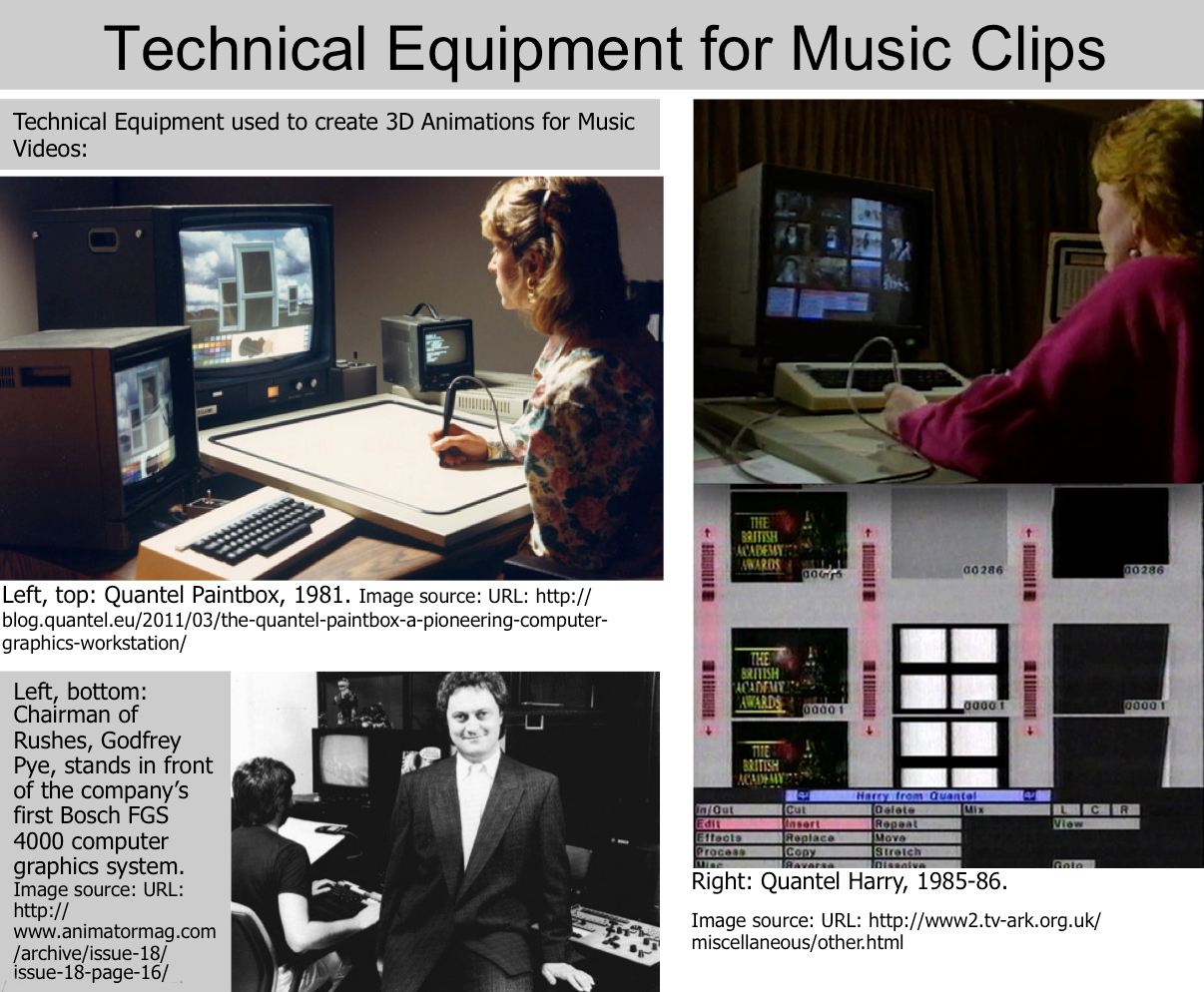
Costello, Elvis: Accidents Will Happen. Music video with animations of Annabel Jankel and Rocky Morton, 1978.
In 1978 Annabel Jankel and Rocky Morton created a music video with animated drawings for Elvis Costello´s "Accidents will Happen". It ended with vector graphics presenting outlines of Costello´s face. 45
Tharp, Twyla/Byrne, David: The Catherine Wheel, dance performance, 1981. Computer animation by Rebecca Allen for the film version, 1982.
In 1982 Rebecca Allen drafted the figure of Saint Catherine in Twyla Tharp´s 90 minutes long dance film "The Catherine Wheel" von 1982 (with music by David Byrne) as a computer animation with chaotically crossing white lines on a black background and as a multicoloured wire frame figure. The dancer Sara Rudner coordinated her actions with the motions of the animated saint, thus provoking observers to ask themselves how long it will still be recognisable who reacts to whom.
Steve Miller Band: Abracadabra, 1982. Music video by Peter Conn. Screenshot from the Animator´s Site.
In 1982 Peter Conn (Homer & Associates) created a music video for Steve Miller Band´s song "Abracadabra" by transforming a digitised film with the software "Forth" running on the "8-bit computer paint system" that was developed by Paul Rother (Homer & Associates). The console consisting of 24 channels for editing and the paint system were utilised for a presentation of relations between actress, actors and magic props in a studio installed with low expenses. A "burning flame" praised in the lyrics reoccurs several times in the video. In several sequences the image processing via paint system takes on a life of its own in the form of colour patterns built by overlapping rectangles spreading out for a short time and then disappearing again, meanwhile coloured squares sparking out of a sorcery query their representing function by a confetti-like colourfulness. The love song can be related to the bandleader and composer Steve Miller blended in with his guitar at the beginning and at the end. 46
Powers, Will (Goldsmith, Lynn): Adventures in Success, 1983. Music video by Rebecca Allen.
In 1983 Rebecca Allen (animation) with Will Powers (Lynn Goldsmith), Robert Palmer and Sting (music) thematise in "Adventures in Success" a seemingly automated wish fulfillment: The message of the refrain "It´s you. Make it habit. Make it happen. Only you" tells us that the trail from the wish to its successfull realisation is nothing more than a demand for an imaginary self creation. In the computer animated clip three masks move their mouths as if they sing the refrain. Via texture mapping (see chap. IV.2.1.3) two of the three masks show the facial features of Will Powers. If the masks turn so far that they have to unveil their backside, then reappear their fronts: They are only facades. The impression of a reversal of the direction is produced by an optical illusion.
In "Adventures in Success" Allen melds film recordings with two- and three-dimensional animations. The two-dimensional animations look often like cartoon figures and allude to advertising claims. 47
Ashley, Robert: Perfect Lives, 1983. Video opera, visualised by John Sanborn and Dean Winkler.
John Sanborn and Dean Winkler visualised Robert Ashley´s "Perfect Lives" (1983). The composer Ashley performs the multiple storylines. He and the piano player "Blue" Gene Tyranny dominate image and sound: Repeating motifs are Ashley´s upper body with hands gesticulating in the course of his speech presentation and fade-ins on "Blue" Gene Tyranny´s hands playing piano. Ashley, Sanborn, Tyranny and others involved worked with variations of leitmotifs on the levels of images, sound and speech. They created a postmodern "video opera" with seven half-hour-long episodes. 48
Emshwiller, Ed/Smith, Alvy Ray: Sunstone, video, 1979.
Ashley, Robert: Perfect Lives, Part VII: The Backyard, 1983. Video opera, visualised by John Sanborn and Dean Winkler.
The animation programmed digitally by Alvy Ray Smith in 1979 for Ed Emshwiller´s "Sunstone" treated images in the virtual space like turning windows in a cube-like arrangement. 49 Smith´s animation anticipated Sanborn´s and Winkler´s sequence in "Part VII: The Backyard" in "Perfect Lives" with Ashley speaking in an associative manner about a "polychrome heart service". On the cube´s sides appear Ashley´s head and Tyranny´s hands playing piano. Between the loose coupled planes of the cube appears a little cube reflecting the form of the wider cube and its projections on each plane.
Tacuma, Jamaaladeen: Renaissance, 1984. Music video by John Sanborn and Dean Winkler.
In 1984, for the opening of the Computer Museum in Boston, Sanborn and Winkler created the clip "Renaissance" accompanying Jamaaladeen Tacuma´s funk jazz instrumental music. The video with its images of Boston Harbor, stereometric bodies flying above raster planes and turning grids can be observed as if it is created by using elements of the history of computer animations in a toy world. The animation was built with a Quantel Paintbox (since 1981) and integrated spatial layers for recombinations and transformations of buildings and stereometric objects.
Between the video segments of "Abracadabra" Conn changes the camera perspective on the studio room. The actress and the fireballs are the constants between the segments. On the other hand, Sanborn and Winkler choose for "Perfect Lives" a multi-perspective montage-pictorial space constituted by fade-ins with changes in the type of composition. Sanborn and Winkler create in "Renaissance" an image space graded in deep layers, but buildings and stereometric objects become moving motifs as if flying objects constitute the urban space. The extensions into the depth of the image space change with the constellations consisting of arbitrary multipliable and manipulable elements. "Renaissance" is an example for the transition from film recordings edited in post-production to videos with image spaces mostly constituted by computer animations. In "Adventures in Success" Allen varies the modes of representation. Cuts are softened to transitions via corresponding background designs of the cartoons representing projections of a better self. In contrarary Sanborn and Winkler present in "Renaisance" continuous transformations of the image space by digital image processing: from cutting sequences to the transformations of the image space by digital image processing.
Dire Straits: Money for Nothing, 1985. Music video by Steve Barron.
In 1985 Steve Barron produced a clip to Dire Straits´ "Money for Nothing". The composer Mark Knopfler featured a seller´s thoughts: Musicians receive "Money for Nothing". Knopfler wrote the lyrics in memorizing the comments of a seller whom he met at a "hardware department in a television/ custom/ kitchen/ refrigerator/ microwave appliance store". 50
Ian Pearson and Gavin Blair used the animation system Bosch FGS-4000 and a Quantel Paintbox. They preferred monochrome surfaces and renounced shadings and textures. The animation artists divided the seller in two virtual figures ("Sal" and "Harv") composed with stereometric volumes. The virtual sellers acted in simulations of a sitting room with a TV and a salesroom with a television wall and a large projection. The MTV lifestyle mentioned in the lyrics got its visual counterpart in the MTV logos presented on the television wall. Film recordings of a Dire Straits concert appeared on screens within the virtual space. Several times these concert recordings took over the complete screen and replaced the virtual space. Some parts of the live recordings were edited by rotoscoping and it looks as if the contours of microphones and others have been traced with a highlighter.
In contrast to the fade-ins with the musicians in concert the sellers are animated as combinations of stereometric elements carrying appliances through the salesroom. The function of this deindividualising typecast is ambivalent: Meanwhile it offers the sellers a protection by anonimisation, it is degrading, too. With the accentuation of the criticism´s function as a psychic valve of humans in dependent working conditions listeners are influenced to understand the sellers´ utterances as improper. With the animation of their bodies as combinations of blocks the virtual sellers appear as caricatures of real sellers because the whimsical faces and the gaudy colorization provoke doubts concerning the adequacy of their ciriticism.
Jagger, Mick: Hard Woman, 1985. Music video by Digital Productions.
In 1985 Digital Productions created for Mick Jagger´s "Hard Woman" animations on the super computer Cray X-MP (since 1983) with the company-owned software "Digital Scene Simulation". The body volumes of a female and a male figure are only slightly outlined by `luminous´ colored lines meanwhile the background shines through. Not only "Hard Woman", the subject of the lyrics, but also Jagger appear as figures constituted by lines. Furthermore film recordings of the singer appear within a street simultaneously in several entrances of the animated houses. The content of the lyrics is not interpreted by the animation: It plays visually around some elements of the lyrics. 51 The 3D animations of the `luminous´ stick figures are further developments of the 2D figures created by Allen for Tharp´s "The Catherine Wheel" (see above).
If the lyrics contain only variations of the subject love then the possibilities to create extraordinary music videos are very limited, if animators are restricted to visualise motifs of the lyrics. Then computer animators are not only incapable to change the lyrics´ trivial and redundant characters but rather they inforce it. At least Conn´s video for "Abracadabra" (see above) and "Hard Woman" suggest this conlcusion.
The huge hits as "Video of the Year Winners" of the broadcast MTV in Los Angeles were in 1986 the clip for "Money for Nothing" by the Dire Straits and in 1987 the clip for "Sledgehammer" by Peter Gabriel.
Gabriel, Peter: Sledgehammer, 1986. Music video by Steven R. Johnson.
In 1986 Aardman Animation and Brothers Quay were directed by Steven R. Johnson to create a clip for Peter Gabriel´ s "Sledgehammer". The clip is realised without computerised image processing and takes up early animation methods with his fast cuts and fade-ins of `flying´ objects that move through the image space. The scenes with modelling clay animations incorporate elder animation methods for the revivification of inanimate objects. The motion animation via pixilation is not only used for the modelling clay figures but demonstrated with the singer Peter Gabriel, too: Recordings of his head are edited frame by frame – he appears as "living stop motion puppet". So he is a figure in the video that is treated in the same way as the modelling clay figures. Peter Gabriel is said to have been lied 16 hours under a sheet of glass meanwhile the animation artists recorded the takes.
"Sledgehammer" offers in the genre music video a successful counter-image to music videos with computer animation. Nevertheless the counter-image offers also artificial image spaces, montages of moved objects in unreal sizes and fast image or cut sequences. 52 "Sledgehammer" became the most sent clip in the history of the MTV station.
Kraftwerk: Musique non Stop, 1986. Music and video by Rebecca Allen.
When Rebecca Allen started in 1983/84 to prepare a clip for Kraftwerk´s "Musique non Stop" she used the same equipment of the Computer Graphics Laboratory at the New York Institute of Technology, as in "Adventures in Success" (see above). Because Kraftwerk´s musicians finished the sound studio editing of their recording only in 1986, Allen was not able to complete her animation at an earlier date.
In her animation she uses no film recordings of the musicians. Nevertheless with her animation of heads and bodies she takes over the characteristics of the musicians´ performance in concerts: The four musicians are dressed with the same clothes and with the same hairstyle. They stand in identical distances behind their tables on which their equipments are installed to operate with them.
Allen divided plastic models of the musicians´ heads in fields, photographed them from different angles to receive the informations being relevant for the preparation of animated wire frame models. In the clip these four heads are presented in different arrangements as figures in wire frame simulations (without overlaps), polygon animations and animations with smooth surfaces. At the end of the clip Allen presents recordings of fielded head models reminding crashtest dummies. Then a white masks appears, receiving at first eyes then facial colours before it changes into a black-and-white simulation with lines as basic elements.
Parallel to Kraftwerk´s technopop with its minimalist repetitions and a few variations as well as their de-individualized concert performance with a few standardised gestures Allen combines phase segments of the process to construct the musicians´ 3D-simulations. She presents these elements as if they were segments of a repeatable studio process.
Meanwhile "Sledgehammer" escapes digital smoothness with impure surface stimuli of the film recordings, this smoothness is celebrated by Allen and Kraftwerk: The `impure´ against the reduction to `pure´ elements of a machine-made precision. By taking up Kraftwerk´s hybrid esthetics between human, machine and computer as well as the wire frame animations of the seventies´ science fiction movies (see chap. IV.2.1.4.1), Allen plays with elements precoded as technoid. (The animations of) the humans look as if they are de- and reconstructable like robots. 53
Walczak, Diana/Kleiser, Jeff: Don´t Touch Me, video, 1989.
In 1989 Diana Walczak und Jeff Kleiser present the animation of a female singer in "Don´t Touch Me". The animation created with Wavefront is mentioned in histories of CGI (computer-generated imagery). 54
The singer Perla Batalla was the model for recordings of body motions by Motion Analysis Inc. The motion patterns were translated into a digitised model of an actress called Dozo: Dozo with a smooth skin appearing lifeless moves like Perla Batalla and sings with her voice. Dozo sings lyrics written by Walczak and Kleiser about her situation as a virtual performer (music: Frank Serafine). In "Don´t Touch Me" Kleiser and Walczak used motion capture not anymore as a modular building block system for the presentation of a virtual world parallel to the concerts of a band – like the animated versions of the Kraftwerk´s musicians in "Musique Non Stop" – but present an artificially made star. The audiovisual performance of the music clip presents a musician in a star-like position. But this musician should be able to present himself without concerts, and has to try to become independent of a career as a concert star. Meanwhile the distribution of music clips remains bound to media packages with concert stars, "Don´t Touch Me" is a model for the computer animation of human bodies and their motions developed out of the forms of music videos.
After 1987 the sales of music videos on videocasettes collapsed. The major labels of the music industry reduced their budgets for clips. 55 Music clips remain distributed by television boradcasters like MTV (since 1981): The character of a designed interplay between the levels of image and sound shifts more then before to the promotion of musicians as stars dominating the visualisation. The fast replacements of sequences would have been too time-consuming and expensive for the film animators´ montages of frames at cutting tables. These fast following cuts remained a core element of the promo(tion) style after the decline of the sales of music videos on videocasettes. 56
Kleiser and Walczak conceptualised "Don´t Touch Me" not anymore as a video to a musical work. Instead they designed it as an art film financed by Hewlett Packard to demonstrate in 1989 the technical development of virtual actors in its actual state – without references to stars in concerts.
The combination of simulated figures and life recordings in "Money for Nothing" was a compromise between Mark Knopfler and the task of MTV to present interesting clips instead of documentations of concerts. 57 Between virtual performers as main actors – like Dozo in "Don´t Touch Me" – and their degradation to statists beside filmed concert stars in "Money for Nothing" offers Allen in "Musique Nonstop" a third possibility to relate musicians and computer animation to each other: the simulation with virtual actors as a parallel world to the concert performance and its real actors.
In the eighties the demoscene arose out of the activities of crackers who removed the copy protection (in the software) of computer games and added intros to their copies. These cracktros for the personal computer Commodore 64 (1982-94) were distributed since 1983. Cracktros included the logos of their creators (sometimes moved), a scroll text, graphic elements (sometimes moved), and music. The music was written in formats similar to MIDI files. Furthermore the cracktros contained instructions for computing processes first in assembly language and later for C and C++. 58 The codes were written for computers with 8-bit processors which realised the screen presentation in real time 59, without recognizable time delay. An alternative to these processors of the Commodore 64 offered since 1985 the 16-bit processors of the Commodore Amiga. 60
German Cracking Service: Slamball, cracktro for Commodore C64, 1984 (Botz: Kunst 2011, p.54ss.).
The cracktros were developed to autonomous demos. From 1987 to 1990 groups presented their demos one after another in megademos. 61 Since 1987 a scene for personal computers with the operating system MS-DOS arose and became independent from the Amiga demoscene in 1992. Today demo competitions are organized for participants with different kinds of personal computers of the eighties. 62
RED SECTOR INC: Megademo, Commodore Amiga, 1989 (Botz: Kunst 2011, p.145-153).
Supercomputers and mainframe computers were used for the frame-by-frame creations of film sequences. This technology for computer animation constituted the bottom end of a scale of available computing capacities, and the demoscene built the opposite end using the low computing capacities of personal computers for real time animations. 63 Between these extremes of animations for big and little computers tools were available for digital mini- and microcomputers like Tom DeFanti´s GRASS (since 1973, for DEC PDP 11/45, since 1972, see chap. IV.1.2) and ZGRASS (since 1978, for Datamax UV-1, since 1978) 64 as well as Woody Vasulka´s and Jeffrey Schier´s Digital Image Articulator (1976-78, for DEC LSI-11, since 1975, see chap. IV.1.2). In the eighties Steina and Woody Vasulka realised interesting videos with the Digital Image Articulator. 65 At the same time Mary Jane Veeder developed with ZGRASS a two-dimensional visual language with signets resp. icons as well as a two-dimensional personal language derived from arcade and video games. 66
Veeder, Jane: Montana, video, 1982.
The animations realised with mainframes and supercomputers were oriented to the ideal of hyperrealism. Hyperrealism was (yet) no goal for many digitally produced videos by artists and for the demo scene´s real time animations: Contrary to the simulation machines for cinemas (and advertisement) were alternative concepts exploring the possibilities offered by the computing capacities that were affordable for private persons. Authors of music videos hark back to various artistic as well as cinematic forms of animations and combine the aesthetics of videos and movies. 67
The animations for film sequences being realised with mainframe and supercomputers were commissioned by producers of the entertainment industry. These films should fulfill the expectations of the movie goers. In contrary the animations created by Mary Jane Veeder, Steina and Woody Vasulka with mini- and microcomputers were experimental films made with the goal to find new film forms. On the other hand creators of the demoscene used personal computers to develop their own subculture´s aesthetics with running text-(three-dimensional augmented) icon-combinations despite limited technical possibilities.
The creators of demos practice a counter model to the commercial exploitation of copyrights by the movie distributors and the video game industry. The authors of demos abstain from profits and distribute their products free of charge. This distribution in combination with open software (with sites containing collections of files with codes for free download) sustains a collaborative development of programming. 68 This open culture and its use for collaborative developments became a model for alternative digital cultures.
In the eighties computer art was perceived by humanities scholars from the point of view of a "techno-imaginary". The term stood for a virtuality being valued positive. Recent and possible future developments of digital media and telecommunications were imagined as the constituents of this virtuality. With the upcoming telecommunications (see chap. VI.1.2) scholars foresaw an ubiquitous distribution of signs 69 causing an imagination not only of a deterritorialised socialisation but of a virtual world, too, allowing to connect it to the reality as if we live in an electronic world and need interfaces not as accesses to virtual worlds, but to reality. 70 Paul Virilio´s theses on the development of relations between media, time and territories in the 20th century were combined with Jean Baudrillards theses on simulation 71 to an analysis of an accelerated sign distribution leaving behind referential functions. This sign distribution removes the experience of a material presence into a distance as if the everyday world can be observed only from a historicising and museumising point of view. The "hyperreal" of a remoteness leaving behind the reality as uncatchable infects already the experience of the presence, meanwhile in earlier times this remoteness has been only a problem of reconstructions of the past. 72
On the one hand the exchange of commodities should not always have been a distribution oriented to the exchange value: As proofs serve comparisons with gifts and their functions in not mercantile organised societies. On the other hand in mass media the communication of signs with signs is accelerated in media assisted ways oriented to exchange values replacing communication increasingly by "floating signifiers". The symbolic interaction (communication) looses its community constituting functions and is replaced increasingly by specatacle organisations constituted by corporative organised connections between distribution systems for different kinds of media. Within these connected systems the music video is only one product in a row with others (records-TV-movies-concerts-videos-advertisement). 73
With the Situationists the pure spending of gifts without responding gifts by the donees became a model for free exchange. 74 A precondition for a free exchange is configured by `objects´ or signs not tied to codes as they are constituted by exchange values among others. These ties are transformed under conditions of the "hyperreal" into shadows of its own past in which they arose. Recipients finally accept spectacle organisations, because the signs circulating as parts of these spectacles impregnate the consciousness until it is impossible to distance oneself from imaginations determined by others. The world of illusions constituted by "simulacra" becomes all-embracing. 75 The 3D simulation created with computer animation can be interpreted as a part of the spectacle organisation especially if the simulated objects are presented as parts of an autonomous virtual world.
In a time when computer games still were not able to simulate in a hyperrealistic way a world with immersion producing effects (see chap. VII.1.3.1) the movie "Tron" (see chap. IV.2.1.4) demonstrated how the virtual worlds of computer games provoke fictions of `other worlds´. Nevertheless these worlds behind screens are accessible only by technical interfaces the simulations are primarily experienced as emotionally experienced environments.
Lisberger´s movie shows the fight between the "Master Control Program" and the safeguarding program maintaining the users´ control. This fight reacts to the vision of simulated actors supervising our imaginations of a socialisation in a technically organised world that produces not only games but assimilates itself to them ("gamification"). Nevertheless Tron´s reconstructed balance between virtual and real worlds was presented on a literary level as a science fiction and on a filmic level as a spatialisation of the plot: In "Tron" the computer animation served as a means to realise the literary and filmic fiction of an interaction between human and computer, as it was developed in the plot and in the storyboard with `pencil and imagination´, independent of computing capacities. Contrary to this fictionalisation are we faced today in the web 2.0 with real problems to organise big data with either an open or a hidden control of data streams.
Although Baudrillard tried in his criticism of the simulation and the simulacra to explain the spectacle organisation as a civilisation distributing signs so that its members loose increasingly the capability to recognise dependencies from outside controls, his criticism is tuned by some of his followers to an euphoria over technology. 76
The accelerated distribution of signs can not only be a part of the spectacle organisation of simulations but a cause for the dissemination of gender patterns, too. This possibility arised with the technological means offered by an accelerated computer aided image processing and a layered virtual image space replacing representations of real spaces by possible phase spaces. Peter Weibel presented these spaces in his theses on the "Pictorial Space in Electronic Art" 77 and in collaboration with Valie Export in the performance "Voices from an Inner Space" (1988) 78 as a possible way to a civilisation reorganising itself digitally and transgressing gender specific role patterns.
Export, Valie/Weibel, Peter: Voices from an Inner Space, intermedial performance, Brucknerhaus, Linz 9/17/1988.
After algorithms generating fractals were used in computer animtaion to create formations perceived by humans as landscapes (compare Loren C. Carpenter 1980 in "Vol Libre" and 1982 in "Genesis demo" for "Star Trek II: The Wrath of Khan", see chap. IV.2.1.4.1), Export and Weibel get inovled in "Voices from an Inner Space" with the two-fold tie of computing processes to representing as well as symbolic functions and transgress it unilateral: They dissolve symbolic functions nevertheless they provoke imaginations of bodies beyond gender stereotypes and renounce with it to transgress representing functions, too. However these functions aren´t used anymore for renderings of real states of affairs but for their transgressions.
A precondition of a "chronocraty" accelerating the distribution speed of digital organised knowledge is the distribution of personal computers: In Silicon Valley the counterculture of hackers and early networks became neoliberal (see chap. VI.1.2) 79 and provides with the distribution of personal computers and their increasing capacities the precondition of a technoperspective 80 that is shared by cyberfeminism´s theses on "cyborgs": If biological restrictions of human bodies, as they are given for example by sexual characteristics, become transgressable by new possibilities for biological transformations, then the social ties between the biological sex and gender specific role patterns are obsolete, because the first one becomes as flexible as the last ones. 81
The cyberpunk suggestion of a living with "biochips" facilitates to imagine `the human´ as a "prosthetic god" 83 augmenting himself and being able to extend this process to a transformation of himself into a self-navigating computer. Contrasting to this conception of a technoid self-transformation published by Oswald Wiener already in the midst of the sixties 84 the real problems are, how to generate artificial life by self-transforming computing processes. Each computer and each software set insurmountable limits to self transformations because the transformation rules of computing processes always determine how codes can be developed: The ideal of an unlimited emergence is a technically unreachable long-term goal. 85
In the eighties authors combined the possibilities of 3D simulation with an artificial intelligence and an artificial life taking up concepts of evolutionary art (see chap. IV.3.1 and chap.IV.3.2) as well as with telecommunciation as if these scopes inevitably will grow together to a "cyberspace". 86 But these scopes don´t merge as seamless together as a technoperspective of the eighties promised it. Perhaps "Second Life" fulfills today some of these ideas on the combination of 3D simulations with telecommunication, but this platform offers to bring in ideas on artificial life only on a semantic level but not on an algorithmic level.
Theories of cyberspace obscured that the technical possibilities of 3D simulation needed above all the human imagination to develop image sequences and film sequences: Humans work on the interfaces to computers and computing processes in using systems combining several software evolutions with the goal to prepare phase spaces until they are conclusive for observers whose expectations were shaped by pictorial, photographic and filmic codes. Computer animation is used by creators of movies especially to develop further the concepts of art that were shaped by these codes: Digital animations are `projection machines´ created by humans for humans.
The meaning of the word "machine" can´t be restricted in this context to the frameworks of technical terms. "Machine" is a psychological term, too, which means here the imagination´s fitting together of heterogenous elements to new syntheses 87, but not algorithms of transformations executed in computing processes, in whatever way humans may be able to perceive the presentations produced by these generations (see chap. VIII.1 on modular and generative procedures). The "desiring machine" cinema affects the expectations of computer animations´ creators, meanwhile Evolutionary Art gives the "technical machine" an autonomy by liberating computing processes controlled by algorithms from hereonomous functions. The outputs of these generative processes become an experiment for humans´ observing operations: Here it is open what can constitute the "desiring machine" in the future. 88 But this openness presupposes a generative art using evolution only as a point of reference (see chap. IV.3.3). However Evolutionary Art´s variant simulating plants and bodies binds the "technical machine" to the "desiring machine" by the representational function of the presented sign configurations (as organic bodies) and their symbolic function (via the chosen vicinity to the biologic evolution (see chap. IV.3.1 and IV.3.2)). In this case the "desiring machine" is not liberated by twofold representational and symbolic ties but contents itself with the extension of the imagination and representation of relations between art, technology and science. But these ties were criticised by the philosophers of postmodernism as "dispositives" that should be deconstructed. 89
Dr. Thomas Dreher
Schwanthalerstr. 158
D-80339 München.
Homepage with numerous articles
on art history since the sixties, a. o. on Concept Art and Intermedia
Art.
Copyright © (as defined in Creative
Commons Attribution-NoDerivs-NonCommercial 1.0) by the author, April
2012 (German version)/November 2013 (English version).
This work may be copied in noncommercial contexts if proper credit is
given to the author and IASL online.
For other permission, please contact IASL
online.
Do you want to send us your opinion or a tip? Then send us an e-mail.
Annotations
1 Jones: Synthetics 2011, p.45; Magnenat Thalmann/Thalmann:
Computer 1990, p.14s.; Weibel: Geschichte 1984, p.18.
The digital "frame-by-frame" procedures take up the image-by-image
procedure of the classic films storing sequences of images on footage
made of light-sensitive material (celluloid and others). In the film projector
the spooled film is led over a light emitting projection mechanism respectively
reeled off and spooled again. The procedure of the image production, the
storing medium and the coordination of the image sequences in this medium
are substituted by other procedures in video technology (magnetic tape)
and digitalisation. The "frame-by-frame" procedure permits to
use the entire computing capacity for the production of each of the single
images ("frames") constituting the film. The monitor presentations
of the calculated frames are photographed. A sequence of photos combined
"frame-by-frame" on the footage provokes the impression of movement.
In the eighties the creation of image sequences with a computer executing
programmed transformations from frame to frame was a long-standing process
with results being surprising for the programmers, too. If images were
moved on the film spool or on magnetic tape as well as on the projectors
or recording devices, then the computer was nothing else then an an image
processing device and the playback didn´t cause any problems because
no computing devices were needed (Magnenat Thalmann/Thalmann: Computer
1990, S.14s.). back
2 Auzenne: Visualization 1994, p.33-37; Carlson: History 2003, chap. A Short History of CCRG and ACAD; Magnenat Thalmann/Thalmann: Computer 1990, p.25-35. back
3 Botz: Kunst 2011, p.13-16; Tasajärvi: History 2004, p.12-15. back
4 Mary Jane Veeder, Tom De Fanti, Steina and Woody Vasulka (see chap. IV.1.2, IV.2.1.4.3 with ann.65s). back
5 Auzenne: Visualization 1994, p.28; Goodman: Visions 1987, p.153ss.; Holbrook/Brown: History 1982, p.14; Jankel/Morton: Computer Graphics 1984, p.21 with ill.1.5, p.24; Knowlton: Movies 1968. back
6 Buxton: Interaction 2005, p.1163,1166; Flückiger: Effects 2008, p.53s.; Halbach: Interfaces 1994, p.156ss.; Jankel/Morton: Computer Graphics 1984, p.19; Sutherland: Sketchpad 1963; Wagner: Computergrafik 2004, chap.2. back
7 Carlson: History 2003, Section 3; Goodman: Visions 1987, p.21s.; Krull: Origin 1994 (quotes). back
8 Interfaces for the human-computer interaction:
Alan Kay and his research group at Xerox PARC, Palo Alto (Palo Alto Research
Center): Bardini: Bootstrapping 2000, p.215s.; Flückiger: Effects
2008, p.54; Friedewald: Computer 2009, p.237-355; Manovich: Kay 2007;
Manovich: Software 2008, Part I, Chapter 1; Rheingold: Tools 1985, Chapter
11.
Xerox Star, Apple Lisa und Apple Macintosh (cf. ann.64): Friedewald: Computer
2009, p.343-351,379-409; Matis: Wundermaschine 2002, p.270s. back
9 Lansdown: Computing 1980; Magnenat Thalmann/Thalmann: Computer 1990, p.223; Reichardt: Computer 1971, p.15ss.; Reichardt: Serendipity 1968, p.88ss.; Youngblood: Cinema 1970, p.194s. back
10 Knowlton: Movies 1968, p.68; Noll: Movies 1965;
Robbin: Shadows 2006, p.177ss.
Hardware: Mainframe Computer IBM 7094 (since 1962), Stromberg Carlson
4020 Microfilm Recorder (since 1959), 16mm camera. back
11 Dietrich: Intelligence 1986, p.163; Knowlton: Computer 1964; Magnenat Thalmann/Thalmann: Computer 1990, p.19s.; Reichardt: Computer 1971, p.77s.; Youngblood: Cinema 1970, p.246. back
12 Knowlton: Computer 1964, p.67 (quote). Cf. Auzenne: Visualization 1994, p.29s.,39s.,45; Youngblood: Cinema 1970, p.246-249. back
13 Le Grice: Computer 1974, p.163 (first quote); Sutton:
Vanderbeek 2012, p.320 (second quote).
Knowlton used the experiences he made in collaborations with VanDerBeek
to develop TARPS ("Two-dimensional Alphanumeric Raster Picture System").
With TARPS the films from "Poemfield No.1" (1964) to "Poemfield
No.8" (1967) were created (Lansdown: Computing 1975; Patterson: Vision
2015, Kindle ebook position 1473). As the program used for the realisation
of "Poemfields" Carolyn L. Kane, Gloria Sutton and Gene Youngblood
mention only BEFLIX, bot not TARPS (Kane: Algorithm 2014, Kindle ebook
position 2649; Sutton: Machine 2015, p.173,175; Sutton: Vanderbeek 2012,
p.313,315s.; Youngblood: Cinema 1970, p.246). In "New Talent –
The Computer", when Vanderbeek explains the programming in his description
of the production process, then he mentions only BEFLIX (Vanderbeek: Talent
1970, p.86,91).
On the coloration: Glora Sutton quotes Vanderbeek´s "EAT [Experiments
in Art and Technology] talk, c. 1968": "Starting with a black-and-white
film on one end of an optical printer and projecting it on color based
film and sticking color filters in the way, you superimpose a color layer
over your black-and-white material." (Sutton: Machine 2015, p.173s.).
According to Zabet Patterson the film was "carefully colored by hand."
(Patterson: Vision 2015, Kindle ebook Position 1524. Cf. Kane: Algorithms,
Kindle ebook Position 1490). back
14 Csuri/Shaffer: Art 1968, p.12,97; Jankel/Morton:
Computer Graphics 1984, p.22s. with ill. 1.10.1-4; Youngblood: Cinema
1970, p.202s. Rosen: Record 2006, p.46 with ill.42: "Programming
Assistance: Samuel J. Cardman, and J. Carroll Notestine...Shaffer developed
the technique to bring in short segments of the plotter drawings. Csuri
developed the ideas of morphing, randomness and fragmentation, which were
implemented by Shaffer, Cardman, and Notestine. Charles Csuri, e-mail
to [Margit Rosen]..., 8 May 2006."
Further examples of two- and three-dimensional computer animations in
the sixties:
Pritchett, Tony: Flexipede,
1967-68. Film, 16 mm, b/w, sound, 2 min. 10 sec. In: Mason: Computer 2008,
p.211s.
Yamada, Gaku/Tsukio, Yoshio: The
Art of Fugue, 1968. Film, 16 mm, b/w, sound, 3 min. In: Sakane: Computer
1986, p.204. back
15 Reichardt: Computer 1971, p.81s.; Reichardt: Serendipity 1968, p.75s. back
16 Glowsky: Csuri 2006, p.33,71. In chap. IV.2.1.2 Csuri´s procedure to create animations was sketched out in the description of the film "Hummingbird". back
17 Auzenne: Visualization 1994, p.14,24,55; Burtnyk/Wein: Key-Frame Animation 1974, p.38; Flückiger: Effects 2008, p.113s.; Magnenat Thalmann/Thalmann: Computer 1990, p.25s.,28,48. back
18 Burtnyk/Wein: Key-Frame Animation 1971; Burtnyk/Wein: Key-Frame Animation 1974. back
19 Burtnyk/Wein: Skeleton 1976, p.564. back
20 Roberts: Machine 1963 (cf. Gouraud: Shading 1971, p.87s.); Sutherland/Sproull/Schumacker: Characterization 1974. back
21 Manovich: Mapping 1993, Chap. 3-D Computer Graphics: Interactive Perspectivalism; Wagner: Computergrafik 2004, chap.2.1. back
22 Gouraud Shading: Gouraud: Computer 1971/1979; Gouraud: Shading 1971 (quotation p.90); Magnenat Thalmann/Thalmann: Computer 1990, p.93; Morrison: Computer 1994, chap. 1970-79; Parke: Animation 1972, p.452. back
23 Phong Shading: Magnenat Thalmann/Thalmann: Computer 1990, p.94; Morrison: Computer 1994, chap. 1970-79; Phong: Illumination 1975, p.312: "When planar polygons are used to model an object, it is customary to shade the object by using the normal vectors to the polygons. The shading of each point on a polygon is then the product of a shading coefficient for the polygon and the cosine of the angle between the polygon normal and the direction of incident light." back
24 Magnenat Thalmann/Thalmann: Computer 1990, p.93ss.,147. back
25 Carlson: History 2003, Section 20; Flückiger: Effects 2008, p.58s. with ill.8s., p.86 with ill.10, p.270 with ill.81. back
26 Catmull: Subdivision 1974; Catmull: Computer 1975; Magnenat Thalmann/Thalmann: Computer 1990, p.88; Morrison: Computer 1994, chap. 1970-79; Straßer: Kurvendarstellung 1974. back
27 "Bump Mapping": Blinn: Simulation 1978;
Flückiger: Effects 2008, p.85s.
On James F. Blinn: Auzenne: Visualization 1994, p.52-59. back
28 Magnenat Thalmann/Thalmann: Computer 1990, p.26,30s. back
29 Autodesk, since 1982; Wavefront, since 1984; Prisms, since 1985; TOPAS, since 1986; Pixars Render Man, since 1988 (acquirable since 1989); Autodesk Animator, since 1989 (for personal computer); Wavefronts Composer, since 1991; Wavefronts Kinematon and Dynamation, since 1992; After Effects, since 1993 (see Manovich: Effects Part II 2006, chap. Deep Remixability: "remixability of previously separate media languages"). back
30 Gere: Culture 2008, p.184s.,190ss.; Neuhaus: Gibson 2006. back
31 Parke: Computer 1972, p.452s. back
32 Westworld: Auzenne: Visualization 1994, p.21,53,67s.;
Flückiger: Effects 2008, p.115,424s.; Jankel/Morton: Computer Graphics
1984, p.111; Manning: Blocpix 1975.
Futureworld: Auzenne: Visualization 1994, p.16,21,53; Flückiger:
Bodies 2010, p.7s.; Flückiger: Effects 2008, p.115,423s.; Jankel/Morton:
Computer Graphics 1984, p.118. back
33 Star Wars Episode IV: Jankel/Morton: Computer Graphics
1984, p.111; Weibel: Geschichte 1984, p.27.
Alien: Jankel/Morton: Computer Graphics 1984, p.110s.; Mason: Bits 2006,
p.12-15; Mason: Computer 2008, p.233ss.: Sutcliffe´s "program
was written in FORTRAN with calls to FROLIC subroutines". Colin Emmett
developed the animation software FROLIC and Alan Sutcliffe used it on
a minicomputer Atlas
Lab Prime 400 (since 1976/77). Sutcliffe created a polystyrene model
of the mountains. He used their measures as basic elements of his simulation
(Mason: Bits 2006, p.14). back
34 Auzenne: Visualization 1994, p.85; Carpenter: Computer 1980; Flückiger: Effects 2008, p.66; Franke: Kunst 1986, p.17,32; Magnenat Thalmann/Thalmann: Computer 1990, p.118; Morrison: Computer 1994, chap. History 1980. back
35 Auzenne: Visualization 1994, p.53,67,86; Flückiger:
Effects 2008, p.62,424; Jankel/Morton: Computer Graphics 1984, p.118s.;
Wikipedia: Looker 2012.
Flückiger: Effects 2008, p.424 on the scene with the simulation coming
after the whole body scan: "As in `Westworld´...the digital
figure´s construction is simultaneously present as the narration´s
subject; in the narrow sense no illusionment takes place with the artificial
body, but the representation is framed as technically made..."
Animated sequences in "Westworld", "Futureworld",
"Looker" and "TRON" (see below) were created by Triple-I
(Information International Inc.) (Flückiger: Bodies 2010, p.7ss.,12s.;
Flückiger: Effects 2008, p.62,115,423s.,427; Magnenat Thalmann/Thalmann:
Computer 1990, p.37). back
36 Auzenne: Visualization 1994, p.76s.; Flückiger: Effects 2008, p.66,116s.,132s.; Jankel/Morton: Computer Graphics 1984, p.39,49s.,115ss. with ill. 7.12.1-8; Magnenat Thalmann/Thalmann: Computer 1990, p.35,120. back
37 In 1986 a computer was developed especially for
the animation system: Reyes had complex algorithms implemented on its
graphics machine and was more powerful than its predecessor Pixar and
the Cray X-MP utilised for example by Digital Productions (Conlan: Computers
1986, p.83,90).
Ray Tracing simplifies the calculation of light beams. Not all beams reflected
by an object, but only the reflexes are calculated that became visible
from the observer´s point of view. In the beginning of the seventies
the Ray Tracing technique was used first by the MAGI (Mathematical Applications
Group Inc.) animation system (Flückiger: Effects 2008, p.181s.; Goldstein/Nagel:
Simulation 1971; Magnenat Thalmann/Thalmann: Computer 1990, p.101s.).
back
38 Cook/Carpenter/Catmull: Reyes Image Rendering 1987 (quote p.97). back
39 Reeves: Particle Systems 1983, p.359. Cf. Flückiger: Effects 2008, p.132s.; Jankel/Morton: Computer Graphics 1984, p.39. back
40 Reeves: Particle Systems 1983, p.365-371. back
41 Sims: Particle 1990, p.405. back
42 Carlson: History 2003, Section 6; Conlan: Computers 1986, p.75-83; Flückiger: Bodies 2010, p.12s.; Flückiger: Effects 2008, p.7s.,117,216s.,427; Gere: Culture 2008, p.182ss.; Jankel/Morton: Computer Graphics 1984, p.110 with ill.7.1, p.112-115 with ill.7.2-7.10, p.118s.; Weibel: Musik 1987, p.141. back
43 Auzenne: Visualization 1994, p.62,68; Carlson: History
2003, Section
6; Conlan: Computers 1986, p.75-83; Magnenat Thalmann/Thalmann: Computer
1990, p.37; Morrison: Computer 1994, chap. History
1980.
"Tron"
(1982) as Arcade Game of Bally/Midway Games contained four little games
that included sequences of the movie (Wirsig: Lexikon 2003, p.471). The
game was more successful than the film. back
44 Gere: Culture 2008, p.190s.
The main character in the TV series "Max Headroom" was not simulated
via computer animation: The contemporary techniques of film production
(actor Matt Frewer with make-up) were extended by video editing. Computer
graphics realised in 1987 on a Commodore Amiga for the American version
of the series included only the appearance of the protagonist on monitors.
After an accident (by disregarding the warning "maximum headroom")
the main character "Max Headroom" existed only as a monitor
phenomenon, as prescribed by the plot (Masson: CG 101 1999, chap. History
of Computer Graphics). back
45 Jankel/Morton: Computer Graphics 1984, p.133; Weibel: Musik-Videos 1986, p.40s. back
46 The Catherine Wheel: Jankel/Morton: Computer Graphics
1984, p.35,85,88s.,133.
Abracadabra: Conn: Promos 1983, p.8.
Furthermore: Soma Holiday: Human
Vectors, 1982: with vector graphics, realised by Dov Jacobson with
the "home game machine" "Vectrex": Jacobson: Vectors
2013. back
47 Goodman: Visions 1987, p.163 (Software: system with face parameters developed by Frederick I. Parke, director of the Computer Graphics Laboratory at the New York Institute of Technology. Hardware: Digital Equipment Corporation (DEC) Vax 11/780 (since 1977), Evans and Sutherland Picture System, Ikonas Frame Buffer); Jankel/Morton: Computer Graphics 1984, p.,119,133s. with ill.8.34 back
48 Ashley: Perfect Lives 1991; Machan: Ashley 1986; Nabakowski: Geld 1985.
John Sanborn and Dean Winkler used "Video
Image Processing" for editing (video synthesis and video editing).
Richard Wagner, "Oper und Drama" ("Opera and Drama"),
1952, on the "leitmotif" as a conception of the music drame:
Wagner: Oper 1994, p.163,286,298-308,332s.,349-365,419,446ss., 492s.,
532s. (On the "leitmotif" in "Perfect Lives": John
Rockwell, cited in: Nabakowski: Geld 1985, p.91). back
49 Auzenne: Visualization 1994, p.110s.; Jankel/Morton: Computer Graphics 1984, p.46ss.; Weibel: Geschichte 1984, p.32. Programming: Alvy Ray Smith, Lance Williams und Garland Stern (at the Computer Graphics Laboratory of the New York Institute of Technology, Old Westbury/Long Island). back
50 Knopfler 1994 in: Flanagan: Interviews (undated).
On the music clip "Money for Nothing": Barron: Dire Straits
2006; Girl on Film: Anniversary 2010.
On rotoscoping: Flückiger: Effects 2008, p.110,216. back
51 Flückiger: Bodies 2012, p.10s.; Flückiger:
Effects 2008, p.425s.; Goodman: Visions 1987, p.2s.,162s.,187.
On the economic efficiency of supercomputers for animations (using Digital
Productions as an example): Auzenne: Visualization 1994, p.86ss. back
52 On the interpretation of "Sledgehammer": Drewett/Hill/Kärki: Peter Gabriel 2010, p.57-69,195-209. back
53 Bussy: Kraftwerk 2006, p.154-157. back
54 Flückiger: Bodies 2010, p.9 with ann.8; Flückiger:
Effects 2008, p.424 with ann.8; Magnenat Thalmann/Thalmann: Computer 1990,
p.238; Morrison: Computer 1994, chap. History
1980.
Motion Capture was developed by Jim Hanson and Brad de Graf (Morrison:
Computer 1994, chap. History
1980). In the closing credits of "Don´t Touch Me"
De Graf is named as one of the "body flexing software consultants".
The face animation was realised by the interpolation of key frames using
software developed by Larry Weinberg. The body animation was created with
software from Konrad Witz. back
55 Wikipedia: MTV Video Music Award 2012. back
56 Fast following cuts resp. fast change of short sequences
in music videos: Poschardt: Video 2004, p.14.
After 1987 exceptions from the music video as a promotion for the concert
star are for example Daft Punk (because of their self chosen anonymity
(f.e. "909
Revolution" (1998), directed by Roman Coppola)) and Aphex Twin
(f.e. "Rubber
Johnny" (2005) by Chris Cunningham). back
57 Barron: Dire Straits 2006. back
58 On the form of Cracktros: Botz: Kunst 2011, p.14;
Tasajärvi: History 2004, p.13.
Cracktros, since 1983 for Commodore 64: Botz: Kunst 2011, p.14,46,51s.,63s.
Examples by TRIAD und FAIRLIGHT: Botz: Kunst 2011, p.77s.
Programming languages of the cracktros: Botz: Kunst 2011, p.59s. back
59 Botz: Kunst 2011, p.15. back
60 Botz: Kunst 2011, p.46-50,103-107; Matis: Wundermaschine
2002, p.283ss.
The illegal copies of computer games made and distributed by a cracktro
scene dominated by Commodore users caused a decrease of the sales being
earned by game enterprises with their versions for the Commodore computers.
After all the game producers reduced the versions made for Commodore personal
computers.
Commodore had no success with its efforts to reach more clients of business
computers. One of the reasons for this failure was Commodore´s fame
as a producer of personal computers for gamers and creators of videos.
These people used the capabilities of Commodore computers for graphics
presentations and the tape deck for audio casettes (Tasajärvi: Demoscene
2004, p.12; Wikipedia: Amiga Software 2012, chap. Piracy). In 1994 the
image problems originating in these technical characteristics as well
as other reasons led to the bankruptcy of Commodore Business Machines.
In 1986 Andy Warhol demonstrated in a TV programme the capabilities that
personal computers offer to creators of graphics: He used a paint system
(Graphicraft by Commodore Amiga Inc.) on a Commodore Amiga 1000 to rework
a digital image representing Deborah Harry (Goodman: Visions 1987, p.89).
Warhol showcased how simple it was to use a Graphical User Interface (GUI)
(Lambert: Computer 2003, chap.6: The
Act of Using) and presented the graphics possibilities of the Commodore
Amiga 1000. The demoscene did not need programmes that kept users via
GUI away from the source code. back
61 Botz: Kunst 2011, p.132-153 (with an interpretation of Red Sector´s Megademo 1989, from p.145 onwards). back
62 Botz: Kunst 2011, p.15,220-232,241-249; Reunanen: Computer 2010, p.47s. back
63 Important producers of personal computers were in the seventies and eighties: Xerox (Alto, 1972; Star, 1981); MITS (Altair 8800, since 1974); IMSAI (8080, since 1975); Apple (Macintosh, since 1976; Apple II, since 1977); Commodore (PET, since 1977; C 64, since 1982; Amiga, since 1985); Atari (400/800, since 1979); IBM (IBM 5150 Personal Computer, since 1981). Lit.: Augarten: Bit 1984, p.270-281; Friedewald: Computer 2009, p.366-409; Matis: Wundermaschine 2002, p.271-288. back
64 ZGRASS:
Dietrich: Real Time Animation Techniques 1982; Jankel/Morton: Computer
Graphics 1984, p.84; Magnenat Thalmann/Thalmann: Computer 1990, p.33.
Datamax UV-1 is
a small computer constructed for ZGRASS. Bally planned to market the Datamax
UV-1 as a home computer. Datamax UV-1 should have to compete with the
Apple II (see ann.63). But Bally gave up this sphere of business in 1980.
back
65 Vasulka, Woody: Bad, 1979 and Artifacts, 1980. In:
see chap. IV.1.2 with ann.45.
Vasulka, Steina: Selected
Treecuts, 1980. In: Hatanaka/Koizumi/Sekiguchi: Vasulka 1998, p.19.
back
66 Veeder, Mary Jane: Montana,
1982. In: Magnenat Thalmann/Thalmann: Computer 1990, p.33s.; Popper: Electra
1983, p.418s.
Furthermore with ZGRASS:
Cuba, Larry: Calculated
Movements, 1985. In: Youngblood: Cuba 1986. Further examples: Jankel/Morton:
Computer Graphics 1984, p.82 with ill.6.6, p.84. back
67 Diedrichsen: Kunstvideo 2004, p.73-78: Feinemann: Kunst 2004, p.87s.; Theweleit: Frühgeschichte 2004, p.58-65; Weibel: Musik 1987. back
68 Botz: Kunst 2011, p.14,17s. back
69 On the Techno-Imaginary: Rötzer: Technoimaginäres
1988, p.66ss.; Rötzer: Technoimaginäres 1989, p.55. The concepts
of a "techno-imagery" are bound to computer technology, meanwhile
Villem Flusser defined the "techno-imagery" independent of this
technology (see ann.76).
Telecommunication and sign distribution: Virilio: Bild 1989; Weibel: Beschleunigung
1987, p.110ss.,125. back
70 Baudrillard: Ecstasy 1983, p.127 ("The subject himself, suddenly transformed, becomes a computer at the wheel, not a drunken demiurge of power."); Rötzer: Technoimaginäres 1989, p.55. back
71 Baudrillard: Simulacres 1981; Virilio: Véhiculaire 1975; Virilio: Intervall 1990. back
72 The Hyperreal: Baudrillard: Simulacres 1981, chap.
VIII.
"Museumification" of the present: Baudrillard: Simulacres 1981,
chap.1.
Cf. Jeudy: Welt 1987, p.10s.; Lübbe: Zeit-Verhältnisse 1990.
back
73 Floating signifiers: Derrida: Ecriture 1967, p.423s.;
Rötzer: Technoimaginäres 1988, p.67.
Marketing strategies connecting distribution systems for different kinds
of media and the music videos within these strategies: Weibel: Musik-Videos
1986, p.27,38s.
Spectacle-organisation: Debord: Société 1967/1992, chap.1-3,
p.9-41; Dreher: Performance Art 2001, p.353 with ann.574. back
74 Dreher: Valie Export/Peter Weibel 1992, p.19s. back
75 Baudrillard: Simulacres 1981, chap. XVII. back
76 Villem Flusser uses the term "techno-imagination" in a positive sense for an exploration of the possibilities offered by the technological progress to create new `technical images´ (Flusser: Umbruch 1998, p.169,209-222; Krtilova: Bild-Theorie 2010, p.11). Flusser explained these possibilities at a point in time when the correlations between technical and social progress seemed to open new perspectives on a better future. back
77 Weibel: Raum 1986. Cf. Weibel: Beschleunigung 1987, p.40s.,117ss.,125; Weibel: Ausstieg 1989, p.72. back
78 Dreher: Valie Export/Peter Weibel 1992; Schuler: Weibel 1997, p.258-263,276; Weibel: Stimmen 1988. back
79 Gere: Culture 2008, p.142-149. back
80 Weibel: Beschleunigung 1987, p.152: "High performance computers should become cheaper like electricity in earlier times." back
81 Haraway: Cyborg Manifesto 1991, p.150. back
82 Gibson: Zero 1986. Cf. Baudrillard: Videowelt 1988. back
83 Dreher: Performance Art 2001, p.349s. with ann.571. back
84 Wiener: Bio-Adapter 1965-66. back
85 Cariani: Emergence 1991; Whitelaw: Metacreation 2004, p.217-221; see chap. IV.3.4. back
86 F.e. Rötzer: Technoimaginäres 1988, p.66ss.,73s. back
87 Schmidgen: Unbewußte 1997, esp. p.76s.,145ss.: "[Gilles] Deleuze and [Félix] Guattari...tell us that the technical machine is a representation of the desiring machine." (p.77) back
88 Schmidgen: Unbewußte 1997, p.75-81. back
89 Deconstruction: Derrida: Semiologie 1986, p.80s.
Dispositives: Foucault: Jeu 1977. back
[ Table of Contents | Bibliography | Next Chapter ]
[ Top | Index NetArt | NetArt Theory | Home ]
